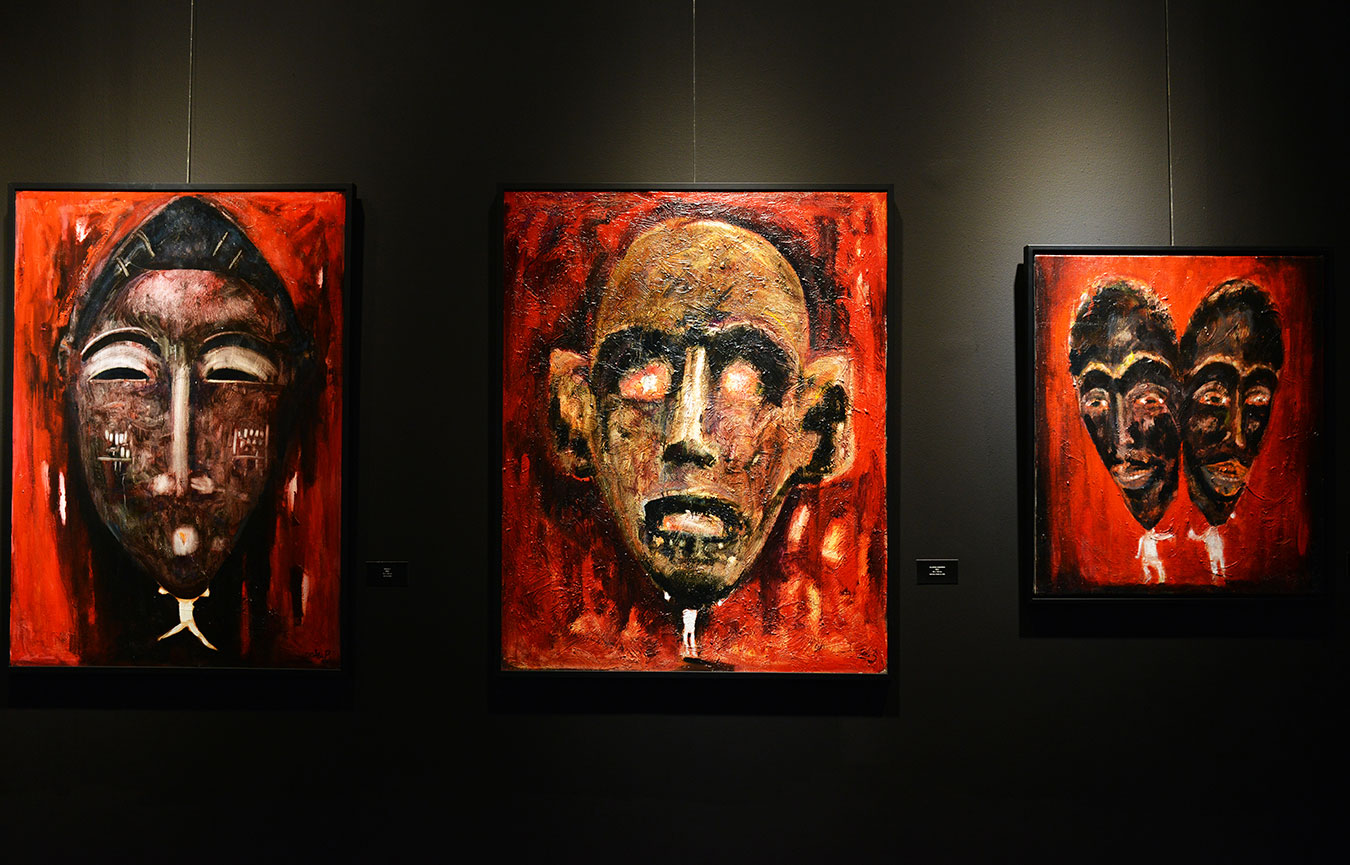-
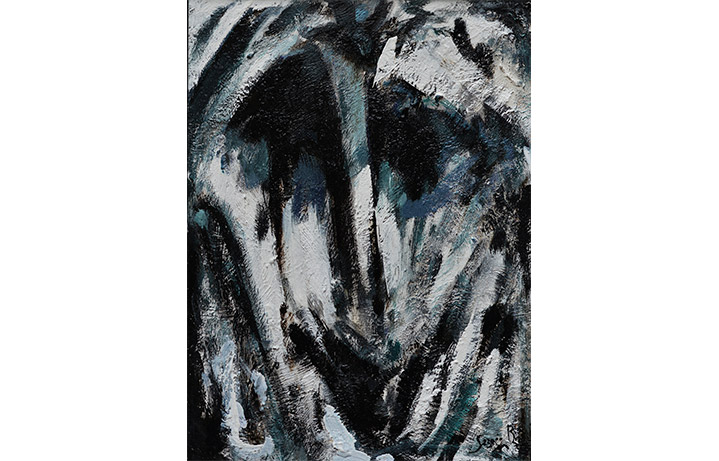
Face like stone
Technique: Oil painting on canvas Dimensions: 13.8x19.6 inCritical signsSergio Boldrin Venice, a Place of the Soul
By Gabriella Niero
Colours incisively applied as dynamic segments turn the profiles of Venetian architectures into monumental façades. The spasmodic rhythm of the brush strokes shakes the giddy heights of the buildings with their dark windows, tracing the shaky profile of walls testifying to a remote and glorious past.
Spare surfaces waver against the sky. Beyond them is a glimpse of the void, giving a disquieting feel. A jester acts as a silent onlooker in this unusual urban context – a great mocking mask with a grotesque expression that follows Venice as it inexorably dissolves. This shift of colours is an immediately perceivable feature of Sergio Boldrin's painting. The viewer will be stunned and captivated by the artist's very personal take on the city, his city. There is no rhetoric here, no aesthetic complacency – only the genuineness of an enchanted place that is losing its historical reference points over time. Within this process of decline, Boldrin's art may be seen to express a sincere awareness, in the form of a mood, a poetic engagement which serves to interpret local malaise.
Urban architectures blend with one another and boldly intertwine on the surface of the paintings, creating vast monumental settings. It becomes difficult to detect any eastern styles or influences here, as all we can make out are mysterious, dream-like buildings which show an upside-down perspective in their interiors. It as if we were gazing at a vast papier mâché theatre resting on the fragile soil of the lagoon, gradually transcending it as it moves upwards. Like trees, the old palaces turn to the sky, stretching their roots for one last time towards the unstable surface they originated from.
Boldrin's painting, therefore, expresses a reality which emerges through observation, blending reason and feelings. His is a sophisticated research, which often crosses the threshold of dreams (or possibly nightmares), yet without ever losing touch with genuine reality. People who know and love Venice today see it as a melancholy city that has been stripped of its inhabitants, a city caught between its apparent existence and the soul which has made it so magnificent over time. Ruin, decay and the indifference of the majority speak of a lifeless city for Boldrin. Regrettably, Venice is losing not just its beauty, but also its identity. The jester's knowing gaze and his grotesque and melancholy mask conceal the conscious feelings of a Venetian. Painting manifestly becomes an intimate pursuit, a form of expressionism that is not merely formal, but which has been fully assimilated and redeveloped according to parameters based on complete emotional engagement – even of a visceral kind in certain paintings. The lines and visual impact of the subjects reveal a marked primitivism almost reminiscent of sculptures in the smoothness of the artist's fields of colour – as best illustrated by his melancholy white buffoon, with its stern and highly contemporary style.
The artist launches a sensory enquiry into the milieu of Venice by expressing visual impressions or extemporaneous images: in his pictorial rendering, he symbolically translates the reflections of known data by following the protean development of his subjects, the endless change of a decadent reflection on the lagoon. Refined and harmonious decorations give way to dense brush strokes; earth colours covered in blues simulate an architecture mottled by time; the shadows of an interior are depicted with dreamy melancholy. Boldrin thus attains his lyrical expression by structuring his images into various levels, using a different colour to define each phase. His images expand or grow denser from one level to the next. They mirror the reflections of an atmospheric crystal. They show the fleeting and precarious beauty of things. Possibly this is why the artist's brush strokes stand out like lacerations, congealing the veins of old marble as if they were deep wounds.
For Sergio Boldrin, each mark or colour influences his will to get to know the present dimension of an object, as if to seize control of its inner development. Painting here reveals the genuine identity of existence. Through a rhythm punctuated by gestural touches, the artist searches for that suspended moment which emerges as the genuine soul of the city. Meanwhile,the jester looks on, enabling the viewer to enter into direct communication with the artist and his reality: the arcane presence of the tragic mask envelops us in boundless pathos.
June 2012, Gabriella Niero
-
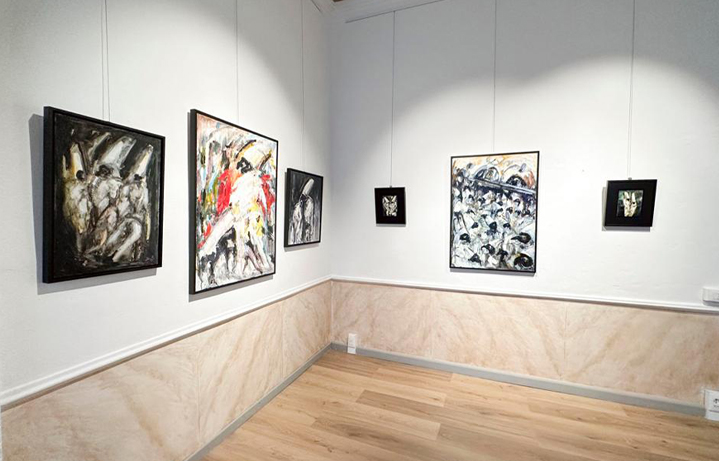
Pulcinella
-
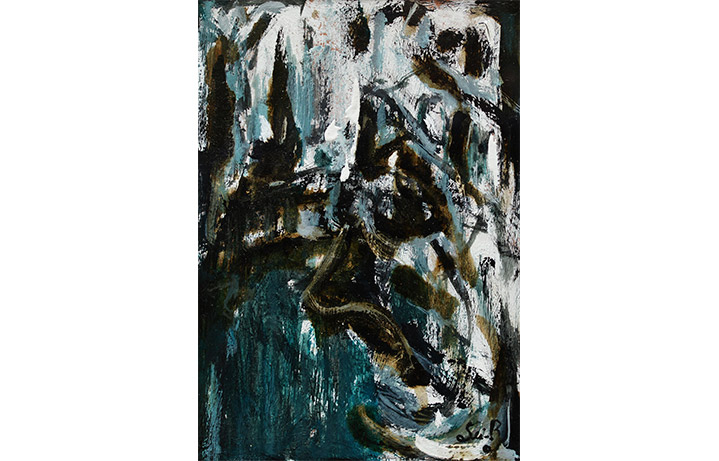
The scream of the harlequin
Technique: Oil painting on wood Dimensions: 4.7x7 inCritical signsSergio Boldrin Venice, a Place of the Soul
By Gabriella Niero
Colours incisively applied as dynamic segments turn the profiles of Venetian architectures into monumental façades. The spasmodic rhythm of the brush strokes shakes the giddy heights of the buildings with their dark windows, tracing the shaky profile of walls testifying to a remote and glorious past.
Spare surfaces waver against the sky. Beyond them is a glimpse of the void, giving a disquieting feel. A jester acts as a silent onlooker in this unusual urban context – a great mocking mask with a grotesque expression that follows Venice as it inexorably dissolves. This shift of colours is an immediately perceivable feature of Sergio Boldrin's painting. The viewer will be stunned and captivated by the artist's very personal take on the city, his city. There is no rhetoric here, no aesthetic complacency – only the genuineness of an enchanted place that is losing its historical reference points over time. Within this process of decline, Boldrin's art may be seen to express a sincere awareness, in the form of a mood, a poetic engagement which serves to interpret local malaise.
Urban architectures blend with one another and boldly intertwine on the surface of the paintings, creating vast monumental settings. It becomes difficult to detect any eastern styles or influences here, as all we can make out are mysterious, dream-like buildings which show an upside-down perspective in their interiors. It as if we were gazing at a vast papier mâché theatre resting on the fragile soil of the lagoon, gradually transcending it as it moves upwards. Like trees, the old palaces turn to the sky, stretching their roots for one last time towards the unstable surface they originated from.
Boldrin's painting, therefore, expresses a reality which emerges through observation, blending reason and feelings. His is a sophisticated research, which often crosses the threshold of dreams (or possibly nightmares), yet without ever losing touch with genuine reality. People who know and love Venice today see it as a melancholy city that has been stripped of its inhabitants, a city caught between its apparent existence and the soul which has made it so magnificent over time. Ruin, decay and the indifference of the majority speak of a lifeless city for Boldrin. Regrettably, Venice is losing not just its beauty, but also its identity. The jester's knowing gaze and his grotesque and melancholy mask conceal the conscious feelings of a Venetian. Painting manifestly becomes an intimate pursuit, a form of expressionism that is not merely formal, but which has been fully assimilated and redeveloped according to parameters based on complete emotional engagement – even of a visceral kind in certain paintings. The lines and visual impact of the subjects reveal a marked primitivism almost reminiscent of sculptures in the smoothness of the artist's fields of colour – as best illustrated by his melancholy white buffoon, with its stern and highly contemporary style.
The artist launches a sensory enquiry into the milieu of Venice by expressing visual impressions or extemporaneous images: in his pictorial rendering, he symbolically translates the reflections of known data by following the protean development of his subjects, the endless change of a decadent reflection on the lagoon. Refined and harmonious decorations give way to dense brush strokes; earth colours covered in blues simulate an architecture mottled by time; the shadows of an interior are depicted with dreamy melancholy. Boldrin thus attains his lyrical expression by structuring his images into various levels, using a different colour to define each phase. His images expand or grow denser from one level to the next. They mirror the reflections of an atmospheric crystal. They show the fleeting and precarious beauty of things. Possibly this is why the artist's brush strokes stand out like lacerations, congealing the veins of old marble as if they were deep wounds.
For Sergio Boldrin, each mark or colour influences his will to get to know the present dimension of an object, as if to seize control of its inner development. Painting here reveals the genuine identity of existence. Through a rhythm punctuated by gestural touches, the artist searches for that suspended moment which emerges as the genuine soul of the city. Meanwhile,the jester looks on, enabling the viewer to enter into direct communication with the artist and his reality: the arcane presence of the tragic mask envelops us in boundless pathos.
June 2012, Gabriella Niero
-
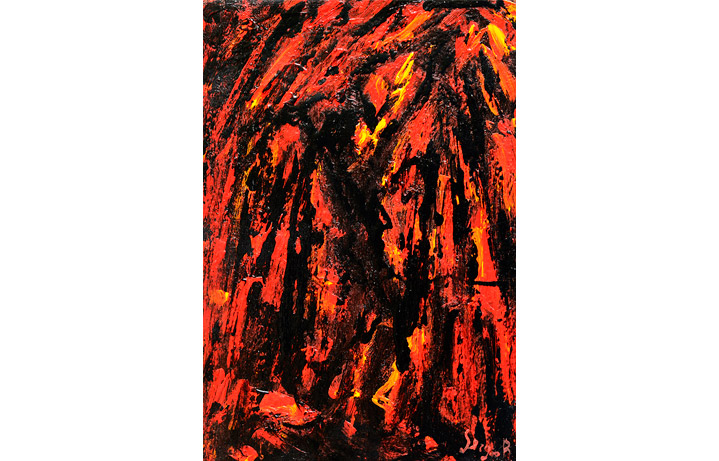
Caryatid
Technique: Oil painting on woodDimensions: 4.7x7 inCritical signsSergio Boldrin Venice, a Place of the Soul
By Gabriella Niero
Colours incisively applied as dynamic segments turn the profiles of Venetian architectures into monumental façades. The spasmodic rhythm of the brush strokes shakes the giddy heights of the buildings with their dark windows, tracing the shaky profile of walls testifying to a remote and glorious past.
Spare surfaces waver against the sky. Beyond them is a glimpse of the void, giving a disquieting feel. A jester acts as a silent onlooker in this unusual urban context – a great mocking mask with a grotesque expression that follows Venice as it inexorably dissolves. This shift of colours is an immediately perceivable feature of Sergio Boldrin's painting. The viewer will be stunned and captivated by the artist's very personal take on the city, his city. There is no rhetoric here, no aesthetic complacency – only the genuineness of an enchanted place that is losing its historical reference points over time. Within this process of decline, Boldrin's art may be seen to express a sincere awareness, in the form of a mood, a poetic engagement which serves to interpret local malaise.
Urban architectures blend with one another and boldly intertwine on the surface of the paintings, creating vast monumental settings. It becomes difficult to detect any eastern styles or influences here, as all we can make out are mysterious, dream-like buildings which show an upside-down perspective in their interiors. It as if we were gazing at a vast papier mâché theatre resting on the fragile soil of the lagoon, gradually transcending it as it moves upwards. Like trees, the old palaces turn to the sky, stretching their roots for one last time towards the unstable surface they originated from.
Boldrin's painting, therefore, expresses a reality which emerges through observation, blending reason and feelings. His is a sophisticated research, which often crosses the threshold of dreams (or possibly nightmares), yet without ever losing touch with genuine reality. People who know and love Venice today see it as a melancholy city that has been stripped of its inhabitants, a city caught between its apparent existence and the soul which has made it so magnificent over time. Ruin, decay and the indifference of the majority speak of a lifeless city for Boldrin. Regrettably, Venice is losing not just its beauty, but also its identity. The jester's knowing gaze and his grotesque and melancholy mask conceal the conscious feelings of a Venetian. Painting manifestly becomes an intimate pursuit, a form of expressionism that is not merely formal, but which has been fully assimilated and redeveloped according to parameters based on complete emotional engagement – even of a visceral kind in certain paintings. The lines and visual impact of the subjects reveal a marked primitivism almost reminiscent of sculptures in the smoothness of the artist's fields of colour – as best illustrated by his melancholy white buffoon, with its stern and highly contemporary style.
The artist launches a sensory enquiry into the milieu of Venice by expressing visual impressions or extemporaneous images: in his pictorial rendering, he symbolically translates the reflections of known data by following the protean development of his subjects, the endless change of a decadent reflection on the lagoon. Refined and harmonious decorations give way to dense brush strokes; earth colours covered in blues simulate an architecture mottled by time; the shadows of an interior are depicted with dreamy melancholy. Boldrin thus attains his lyrical expression by structuring his images into various levels, using a different colour to define each phase. His images expand or grow denser from one level to the next. They mirror the reflections of an atmospheric crystal. They show the fleeting and precarious beauty of things. Possibly this is why the artist's brush strokes stand out like lacerations, congealing the veins of old marble as if they were deep wounds.
For Sergio Boldrin, each mark or colour influences his will to get to know the present dimension of an object, as if to seize control of its inner development. Painting here reveals the genuine identity of existence. Through a rhythm punctuated by gestural touches, the artist searches for that suspended moment which emerges as the genuine soul of the city. Meanwhile,the jester looks on, enabling the viewer to enter into direct communication with the artist and his reality: the arcane presence of the tragic mask envelops us in boundless pathos.
June 2012, Gabriella Niero
-
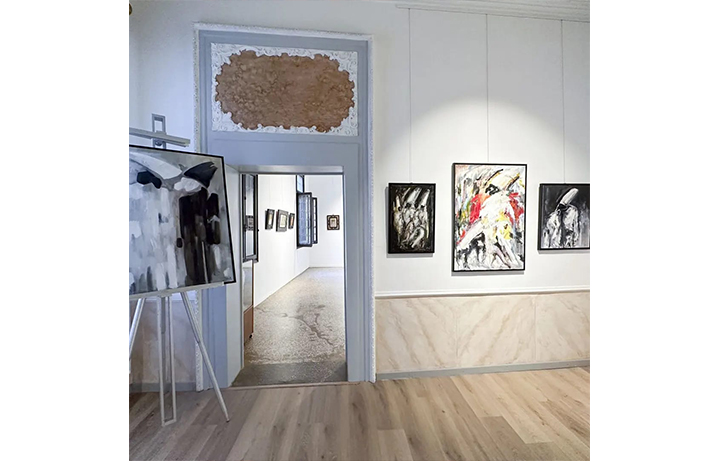
Pulcinella
-
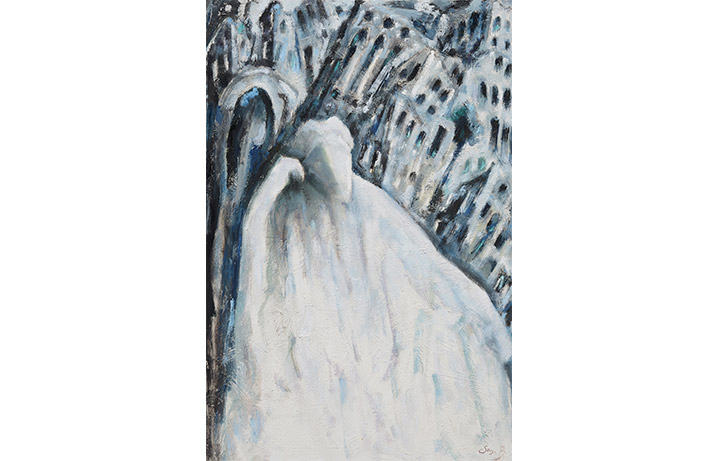
Reflections
Technique: Oil painting on canvas Dimensions: 31.5x47.2 inSoldCritical signsSergio Boldrin Venice, a Place of the Soul
By Gabriella Niero
Colours incisively applied as dynamic segments turn the profiles of Venetian architectures into monumental façades. The spasmodic rhythm of the brush strokes shakes the giddy heights of the buildings with their dark windows, tracing the shaky profile of walls testifying to a remote and glorious past.
Spare surfaces waver against the sky. Beyond them is a glimpse of the void, giving a disquieting feel. A jester acts as a silent onlooker in this unusual urban context – a great mocking mask with a grotesque expression that follows Venice as it inexorably dissolves. This shift of colours is an immediately perceivable feature of Sergio Boldrin's painting. The viewer will be stunned and captivated by the artist's very personal take on the city, his city. There is no rhetoric here, no aesthetic complacency – only the genuineness of an enchanted place that is losing its historical reference points over time. Within this process of decline, Boldrin's art may be seen to express a sincere awareness, in the form of a mood, a poetic engagement which serves to interpret local malaise.
Urban architectures blend with one another and boldly intertwine on the surface of the paintings, creating vast monumental settings. It becomes difficult to detect any eastern styles or influences here, as all we can make out are mysterious, dream-like buildings which show an upside-down perspective in their interiors. It as if we were gazing at a vast papier mâché theatre resting on the fragile soil of the lagoon, gradually transcending it as it moves upwards. Like trees, the old palaces turn to the sky, stretching their roots for one last time towards the unstable surface they originated from.
Boldrin's painting, therefore, expresses a reality which emerges through observation, blending reason and feelings. His is a sophisticated research, which often crosses the threshold of dreams (or possibly nightmares), yet without ever losing touch with genuine reality. People who know and love Venice today see it as a melancholy city that has been stripped of its inhabitants, a city caught between its apparent existence and the soul which has made it so magnificent over time. Ruin, decay and the indifference of the majority speak of a lifeless city for Boldrin. Regrettably, Venice is losing not just its beauty, but also its identity. The jester's knowing gaze and his grotesque and melancholy mask conceal the conscious feelings of a Venetian. Painting manifestly becomes an intimate pursuit, a form of expressionism that is not merely formal, but which has been fully assimilated and redeveloped according to parameters based on complete emotional engagement – even of a visceral kind in certain paintings. The lines and visual impact of the subjects reveal a marked primitivism almost reminiscent of sculptures in the smoothness of the artist's fields of colour – as best illustrated by his melancholy white buffoon, with its stern and highly contemporary style.
The artist launches a sensory enquiry into the milieu of Venice by expressing visual impressions or extemporaneous images: in his pictorial rendering, he symbolically translates the reflections of known data by following the protean development of his subjects, the endless change of a decadent reflection on the lagoon. Refined and harmonious decorations give way to dense brush strokes; earth colours covered in blues simulate an architecture mottled by time; the shadows of an interior are depicted with dreamy melancholy. Boldrin thus attains his lyrical expression by structuring his images into various levels, using a different colour to define each phase. His images expand or grow denser from one level to the next. They mirror the reflections of an atmospheric crystal. They show the fleeting and precarious beauty of things. Possibly this is why the artist's brush strokes stand out like lacerations, congealing the veins of old marble as if they were deep wounds.
For Sergio Boldrin, each mark or colour influences his will to get to know the present dimension of an object, as if to seize control of its inner development. Painting here reveals the genuine identity of existence. Through a rhythm punctuated by gestural touches, the artist searches for that suspended moment which emerges as the genuine soul of the city. Meanwhile,the jester looks on, enabling the viewer to enter into direct communication with the artist and his reality: the arcane presence of the tragic mask envelops us in boundless pathos.
June 2012, Gabriella Niero
-
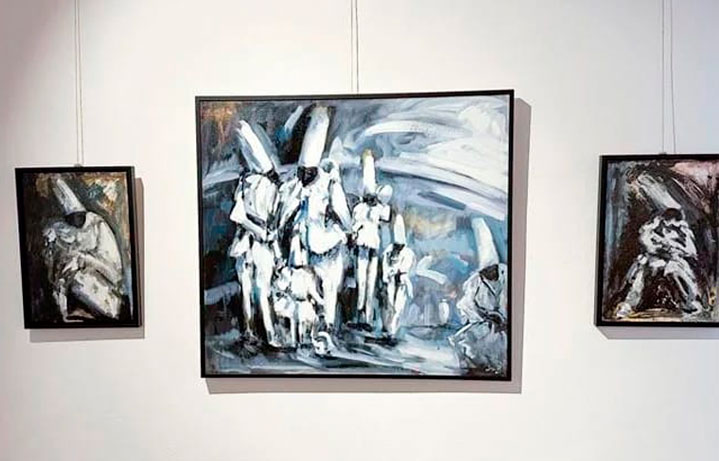
Pulcinella
-
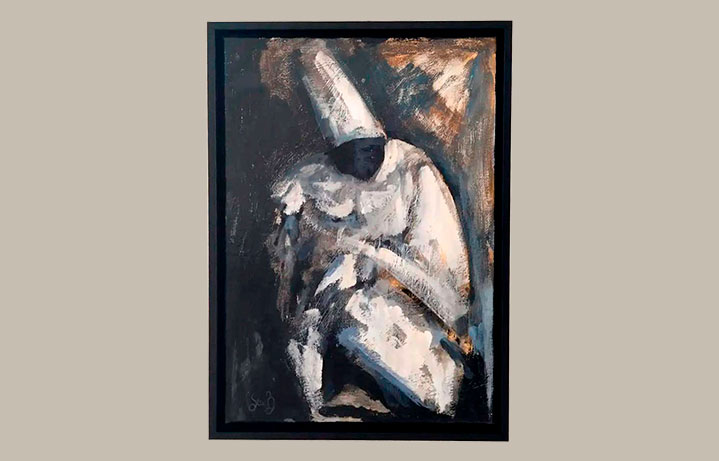
Pulcinella
-
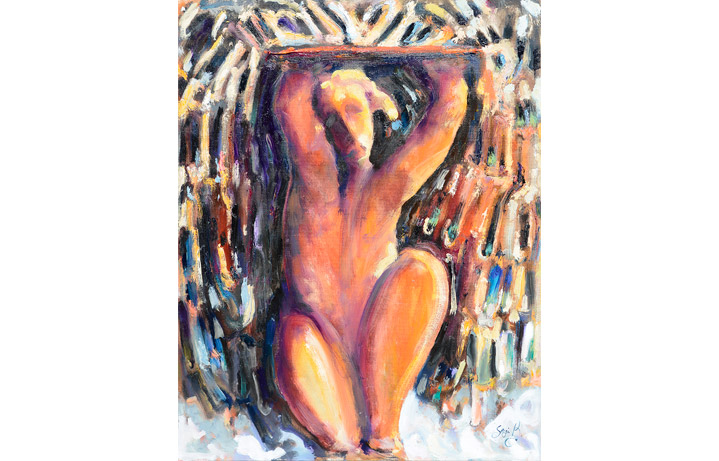
Venetian Caryatid
Technique: Oil painting on canvasDimensions: 31.5x39.4 inSoldCritical signsSergio Boldrin Venice, a Place of the Soul
By Gabriella Niero
Colours incisively applied as dynamic segments turn the profiles of Venetian architectures into monumental façades. The spasmodic rhythm of the brush strokes shakes the giddy heights of the buildings with their dark windows, tracing the shaky profile of walls testifying to a remote and glorious past.
Spare surfaces waver against the sky. Beyond them is a glimpse of the void, giving a disquieting feel. A jester acts as a silent onlooker in this unusual urban context – a great mocking mask with a grotesque expression that follows Venice as it inexorably dissolves. This shift of colours is an immediately perceivable feature of Sergio Boldrin's painting. The viewer will be stunned and captivated by the artist's very personal take on the city, his city. There is no rhetoric here, no aesthetic complacency – only the genuineness of an enchanted place that is losing its historical reference points over time. Within this process of decline, Boldrin's art may be seen to express a sincere awareness, in the form of a mood, a poetic engagement which serves to interpret local malaise.
Urban architectures blend with one another and boldly intertwine on the surface of the paintings, creating vast monumental settings. It becomes difficult to detect any eastern styles or influences here, as all we can make out are mysterious, dream-like buildings which show an upside-down perspective in their interiors. It as if we were gazing at a vast papier mâché theatre resting on the fragile soil of the lagoon, gradually transcending it as it moves upwards. Like trees, the old palaces turn to the sky, stretching their roots for one last time towards the unstable surface they originated from.
Boldrin's painting, therefore, expresses a reality which emerges through observation, blending reason and feelings. His is a sophisticated research, which often crosses the threshold of dreams (or possibly nightmares), yet without ever losing touch with genuine reality. People who know and love Venice today see it as a melancholy city that has been stripped of its inhabitants, a city caught between its apparent existence and the soul which has made it so magnificent over time. Ruin, decay and the indifference of the majority speak of a lifeless city for Boldrin. Regrettably, Venice is losing not just its beauty, but also its identity. The jester's knowing gaze and his grotesque and melancholy mask conceal the conscious feelings of a Venetian. Painting manifestly becomes an intimate pursuit, a form of expressionism that is not merely formal, but which has been fully assimilated and redeveloped according to parameters based on complete emotional engagement – even of a visceral kind in certain paintings. The lines and visual impact of the subjects reveal a marked primitivism almost reminiscent of sculptures in the smoothness of the artist's fields of colour – as best illustrated by his melancholy white buffoon, with its stern and highly contemporary style.
The artist launches a sensory enquiry into the milieu of Venice by expressing visual impressions or extemporaneous images: in his pictorial rendering, he symbolically translates the reflections of known data by following the protean development of his subjects, the endless change of a decadent reflection on the lagoon. Refined and harmonious decorations give way to dense brush strokes; earth colours covered in blues simulate an architecture mottled by time; the shadows of an interior are depicted with dreamy melancholy. Boldrin thus attains his lyrical expression by structuring his images into various levels, using a different colour to define each phase. His images expand or grow denser from one level to the next. They mirror the reflections of an atmospheric crystal. They show the fleeting and precarious beauty of things. Possibly this is why the artist's brush strokes stand out like lacerations, congealing the veins of old marble as if they were deep wounds.
For Sergio Boldrin, each mark or colour influences his will to get to know the present dimension of an object, as if to seize control of its inner development. Painting here reveals the genuine identity of existence. Through a rhythm punctuated by gestural touches, the artist searches for that suspended moment which emerges as the genuine soul of the city. Meanwhile,the jester looks on, enabling the viewer to enter into direct communication with the artist and his reality: the arcane presence of the tragic mask envelops us in boundless pathos.
June 2012, Gabriella Niero
-
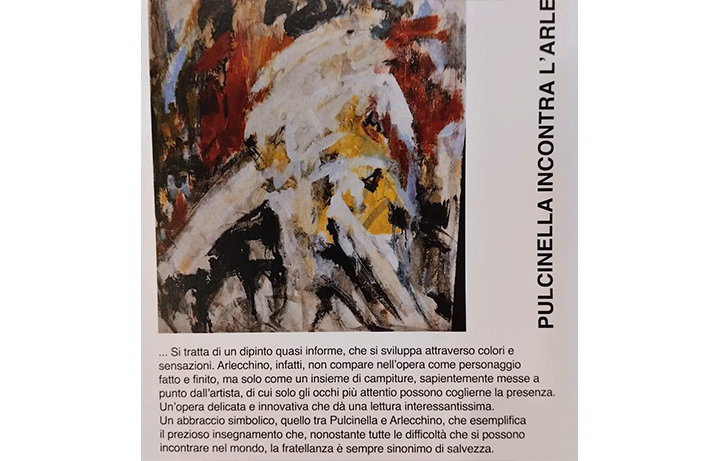
Pulcinella
-
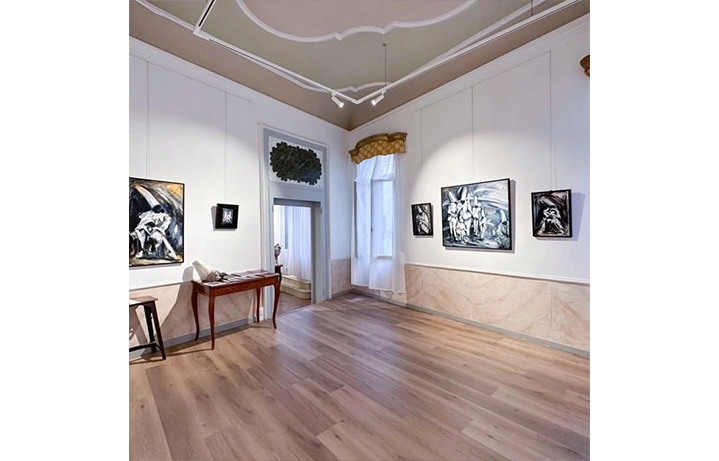
Pulcinella
-
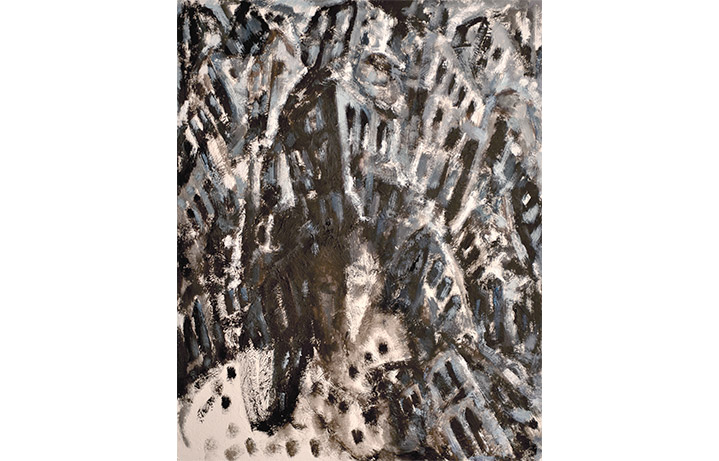
Jester a pois
Technique: Oil painting on canvasDimensions: 31.5x39.4 inCritical signsSergio Boldrin Venice, a Place of the Soul
By Gabriella Niero
Colours incisively applied as dynamic segments turn the profiles of Venetian architectures into monumental façades. The spasmodic rhythm of the brush strokes shakes the giddy heights of the buildings with their dark windows, tracing the shaky profile of walls testifying to a remote and glorious past.
Spare surfaces waver against the sky. Beyond them is a glimpse of the void, giving a disquieting feel. A jester acts as a silent onlooker in this unusual urban context – a great mocking mask with a grotesque expression that follows Venice as it inexorably dissolves. This shift of colours is an immediately perceivable feature of Sergio Boldrin's painting. The viewer will be stunned and captivated by the artist's very personal take on the city, his city. There is no rhetoric here, no aesthetic complacency – only the genuineness of an enchanted place that is losing its historical reference points over time. Within this process of decline, Boldrin's art may be seen to express a sincere awareness, in the form of a mood, a poetic engagement which serves to interpret local malaise.
Urban architectures blend with one another and boldly intertwine on the surface of the paintings, creating vast monumental settings. It becomes difficult to detect any eastern styles or influences here, as all we can make out are mysterious, dream-like buildings which show an upside-down perspective in their interiors. It as if we were gazing at a vast papier mâché theatre resting on the fragile soil of the lagoon, gradually transcending it as it moves upwards. Like trees, the old palaces turn to the sky, stretching their roots for one last time towards the unstable surface they originated from.
Boldrin's painting, therefore, expresses a reality which emerges through observation, blending reason and feelings. His is a sophisticated research, which often crosses the threshold of dreams (or possibly nightmares), yet without ever losing touch with genuine reality. People who know and love Venice today see it as a melancholy city that has been stripped of its inhabitants, a city caught between its apparent existence and the soul which has made it so magnificent over time. Ruin, decay and the indifference of the majority speak of a lifeless city for Boldrin. Regrettably, Venice is losing not just its beauty, but also its identity. The jester's knowing gaze and his grotesque and melancholy mask conceal the conscious feelings of a Venetian. Painting manifestly becomes an intimate pursuit, a form of expressionism that is not merely formal, but which has been fully assimilated and redeveloped according to parameters based on complete emotional engagement – even of a visceral kind in certain paintings. The lines and visual impact of the subjects reveal a marked primitivism almost reminiscent of sculptures in the smoothness of the artist's fields of colour – as best illustrated by his melancholy white buffoon, with its stern and highly contemporary style.
The artist launches a sensory enquiry into the milieu of Venice by expressing visual impressions or extemporaneous images: in his pictorial rendering, he symbolically translates the reflections of known data by following the protean development of his subjects, the endless change of a decadent reflection on the lagoon. Refined and harmonious decorations give way to dense brush strokes; earth colours covered in blues simulate an architecture mottled by time; the shadows of an interior are depicted with dreamy melancholy. Boldrin thus attains his lyrical expression by structuring his images into various levels, using a different colour to define each phase. His images expand or grow denser from one level to the next. They mirror the reflections of an atmospheric crystal. They show the fleeting and precarious beauty of things. Possibly this is why the artist's brush strokes stand out like lacerations, congealing the veins of old marble as if they were deep wounds.
For Sergio Boldrin, each mark or colour influences his will to get to know the present dimension of an object, as if to seize control of its inner development. Painting here reveals the genuine identity of existence. Through a rhythm punctuated by gestural touches, the artist searches for that suspended moment which emerges as the genuine soul of the city. Meanwhile,the jester looks on, enabling the viewer to enter into direct communication with the artist and his reality: the arcane presence of the tragic mask envelops us in boundless pathos.
June 2012, Gabriella Niero
-
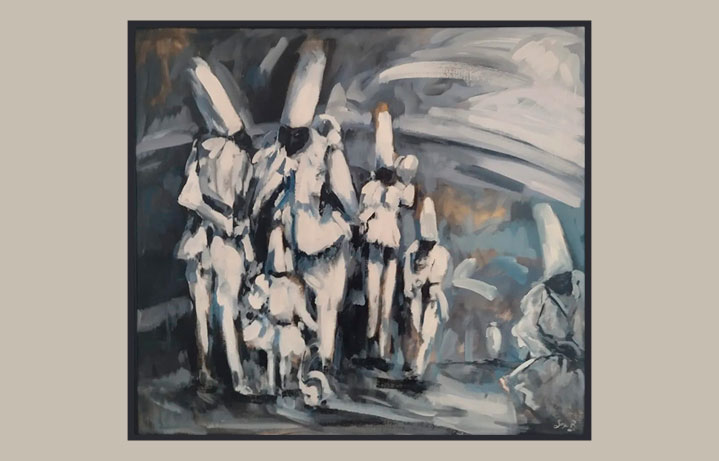
Pulcinella
-
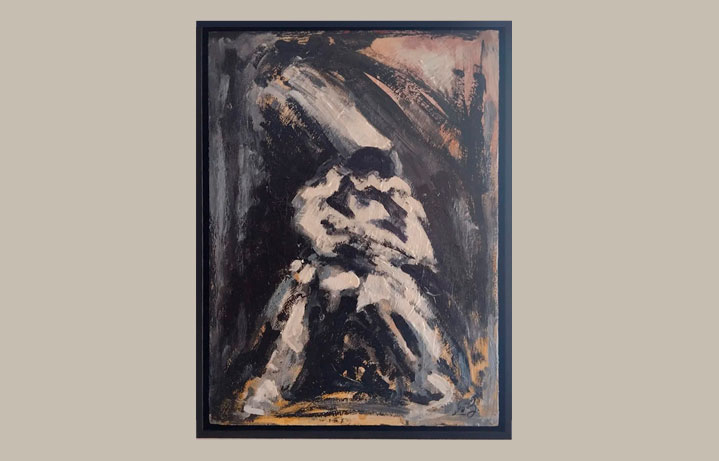
Pulcinella
-
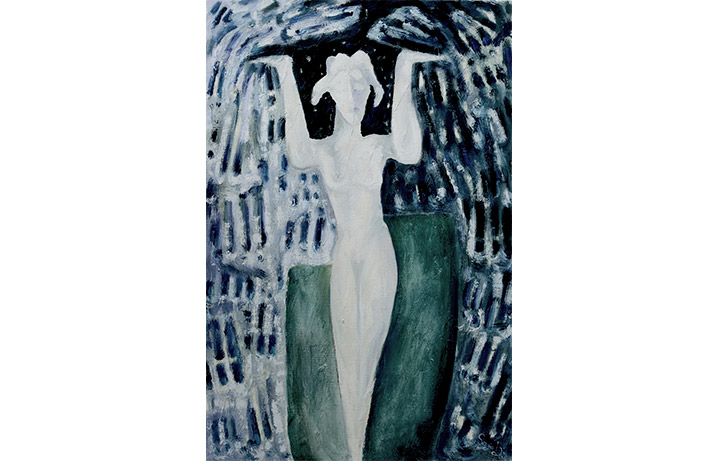
Broken city
Technique: Oil painting on canvasDimensions: 31.5x47.2 inSoldCritical signsSergio Boldrin Venice, a Place of the Soul
By Gabriella Niero
Colours incisively applied as dynamic segments turn the profiles of Venetian architectures into monumental façades. The spasmodic rhythm of the brush strokes shakes the giddy heights of the buildings with their dark windows, tracing the shaky profile of walls testifying to a remote and glorious past.
Spare surfaces waver against the sky. Beyond them is a glimpse of the void, giving a disquieting feel. A jester acts as a silent onlooker in this unusual urban context – a great mocking mask with a grotesque expression that follows Venice as it inexorably dissolves. This shift of colours is an immediately perceivable feature of Sergio Boldrin's painting. The viewer will be stunned and captivated by the artist's very personal take on the city, his city. There is no rhetoric here, no aesthetic complacency – only the genuineness of an enchanted place that is losing its historical reference points over time. Within this process of decline, Boldrin's art may be seen to express a sincere awareness, in the form of a mood, a poetic engagement which serves to interpret local malaise.
Urban architectures blend with one another and boldly intertwine on the surface of the paintings, creating vast monumental settings. It becomes difficult to detect any eastern styles or influences here, as all we can make out are mysterious, dream-like buildings which show an upside-down perspective in their interiors. It as if we were gazing at a vast papier mâché theatre resting on the fragile soil of the lagoon, gradually transcending it as it moves upwards. Like trees, the old palaces turn to the sky, stretching their roots for one last time towards the unstable surface they originated from.
Boldrin's painting, therefore, expresses a reality which emerges through observation, blending reason and feelings. His is a sophisticated research, which often crosses the threshold of dreams (or possibly nightmares), yet without ever losing touch with genuine reality. People who know and love Venice today see it as a melancholy city that has been stripped of its inhabitants, a city caught between its apparent existence and the soul which has made it so magnificent over time. Ruin, decay and the indifference of the majority speak of a lifeless city for Boldrin. Regrettably, Venice is losing not just its beauty, but also its identity. The jester's knowing gaze and his grotesque and melancholy mask conceal the conscious feelings of a Venetian. Painting manifestly becomes an intimate pursuit, a form of expressionism that is not merely formal, but which has been fully assimilated and redeveloped according to parameters based on complete emotional engagement – even of a visceral kind in certain paintings. The lines and visual impact of the subjects reveal a marked primitivism almost reminiscent of sculptures in the smoothness of the artist's fields of colour – as best illustrated by his melancholy white buffoon, with its stern and highly contemporary style.
The artist launches a sensory enquiry into the milieu of Venice by expressing visual impressions or extemporaneous images: in his pictorial rendering, he symbolically translates the reflections of known data by following the protean development of his subjects, the endless change of a decadent reflection on the lagoon. Refined and harmonious decorations give way to dense brush strokes; earth colours covered in blues simulate an architecture mottled by time; the shadows of an interior are depicted with dreamy melancholy. Boldrin thus attains his lyrical expression by structuring his images into various levels, using a different colour to define each phase. His images expand or grow denser from one level to the next. They mirror the reflections of an atmospheric crystal. They show the fleeting and precarious beauty of things. Possibly this is why the artist's brush strokes stand out like lacerations, congealing the veins of old marble as if they were deep wounds.
For Sergio Boldrin, each mark or colour influences his will to get to know the present dimension of an object, as if to seize control of its inner development. Painting here reveals the genuine identity of existence. Through a rhythm punctuated by gestural touches, the artist searches for that suspended moment which emerges as the genuine soul of the city. Meanwhile, the jester looks on, enabling the viewer to enter into direct communication with the artist and his reality: the arcane presence of the tragic mask envelops us in boundless pathos.
June 2012, Gabriella Niero
-
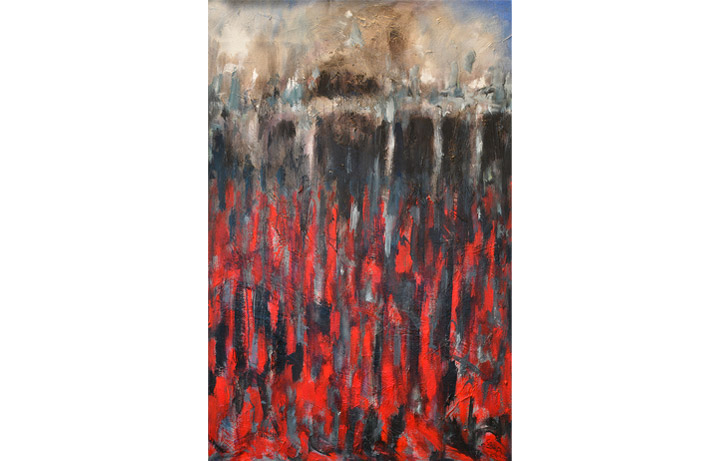
Touch
Technique: Oil painting on canvasDimensions: 23.6x35.4 inCritical signsSergio Boldrin Venice, a Place of the Soul
By Gabriella Niero
Colours incisively applied as dynamic segments turn the profiles of Venetian architectures into monumental façades. The spasmodic rhythm of the brush strokes shakes the giddy heights of the buildings with their dark windows, tracing the shaky profile of walls testifying to a remote and glorious past.
Spare surfaces waver against the sky. Beyond them is a glimpse of the void, giving a disquieting feel. A jester acts as a silent onlooker in this unusual urban context – a great mocking mask with a grotesque expression that follows Venice as it inexorably dissolves. This shift of colours is an immediately perceivable feature of Sergio Boldrin's painting. The viewer will be stunned and captivated by the artist's very personal take on the city, his city. There is no rhetoric here, no aesthetic complacency – only the genuineness of an enchanted place that is losing its historical reference points over time. Within this process of decline, Boldrin's art may be seen to express a sincere awareness, in the form of a mood, a poetic engagement which serves to interpret local malaise.
Urban architectures blend with one another and boldly intertwine on the surface of the paintings, creating vast monumental settings. It becomes difficult to detect any eastern styles or influences here, as all we can make out are mysterious, dream-like buildings which show an upside-down perspective in their interiors. It as if we were gazing at a vast papier mâché theatre resting on the fragile soil of the lagoon, gradually transcending it as it moves upwards. Like trees, the old palaces turn to the sky, stretching their roots for one last time towards the unstable surface they originated from.
Boldrin's painting, therefore, expresses a reality which emerges through observation, blending reason and feelings. His is a sophisticated research, which often crosses the threshold of dreams (or possibly nightmares), yet without ever losing touch with genuine reality. People who know and love Venice today see it as a melancholy city that has been stripped of its inhabitants, a city caught between its apparent existence and the soul which has made it so magnificent over time. Ruin, decay and the indifference of the majority speak of a lifeless city for Boldrin. Regrettably, Venice is losing not just its beauty, but also its identity. The jester's knowing gaze and his grotesque and melancholy mask conceal the conscious feelings of a Venetian. Painting manifestly becomes an intimate pursuit, a form of expressionism that is not merely formal, but which has been fully assimilated and redeveloped according to parameters based on complete emotional engagement – even of a visceral kind in certain paintings. The lines and visual impact of the subjects reveal a marked primitivism almost reminiscent of sculptures in the smoothness of the artist's fields of colour – as best illustrated by his melancholy white buffoon, with its stern and highly contemporary style.
The artist launches a sensory enquiry into the milieu of Venice by expressing visual impressions or extemporaneous images: in his pictorial rendering, he symbolically translates the reflections of known data by following the protean development of his subjects, the endless change of a decadent reflection on the lagoon. Refined and harmonious decorations give way to dense brush strokes; earth colours covered in blues simulate an architecture mottled by time; the shadows of an interior are depicted with dreamy melancholy. Boldrin thus attains his lyrical expression by structuring his images into various levels, using a different colour to define each phase. His images expand or grow denser from one level to the next. They mirror the reflections of an atmospheric crystal. They show the fleeting and precarious beauty of things. Possibly this is why the artist's brush strokes stand out like lacerations, congealing the veins of old marble as if they were deep wounds.
For Sergio Boldrin, each mark or colour influences his will to get to know the present dimension of an object, as if to seize control of its inner development. Painting here reveals the genuine identity of existence. Through a rhythm punctuated by gestural touches, the artist searches for that suspended moment which emerges as the genuine soul of the city. Meanwhile, the jester looks on, enabling the viewer to enter into direct communication with the artist and his reality: the arcane presence of the tragic mask envelops us in boundless pathos.
June 2012, Gabriella Niero
-
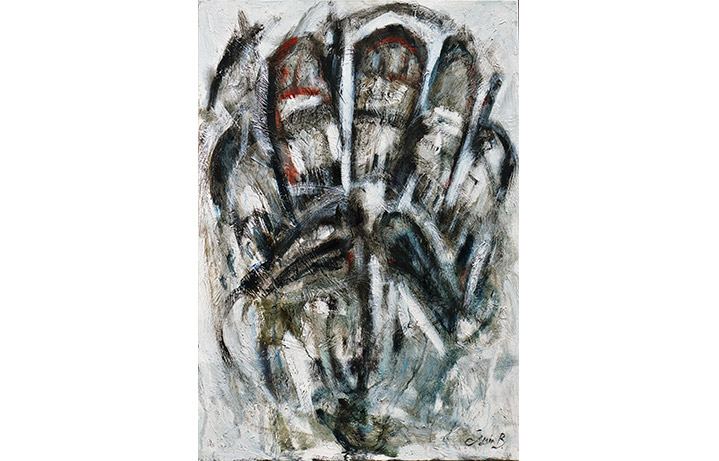
Rialto sad
Technique: Oil painting on canvasDimensions: 27.5x 39.4 inSoldCritical signsSergio Boldrin Venice, a Place of the Soul
By Gabriella Niero
Colours incisively applied as dynamic segments turn the profiles of Venetian architectures into monumental façades. The spasmodic rhythm of the brush strokes shakes the giddy heights of the buildings with their dark windows, tracing the shaky profile of walls testifying to a remote and glorious past.
Spare surfaces waver against the sky. Beyond them is a glimpse of the void, giving a disquieting feel. A jester acts as a silent onlooker in this unusual urban context – a great mocking mask with a grotesque expression that follows Venice as it inexorably dissolves. This shift of colours is an immediately perceivable feature of Sergio Boldrin's painting. The viewer will be stunned and captivated by the artist's very personal take on the city, his city. There is no rhetoric here, no aesthetic complacency – only the genuineness of an enchanted place that is losing its historical reference points over time. Within this process of decline, Boldrin's art may be seen to express a sincere awareness, in the form of a mood, a poetic engagement which serves to interpret local malaise.
Urban architectures blend with one another and boldly intertwine on the surface of the paintings, creating vast monumental settings. It becomes difficult to detect any eastern styles or influences here, as all we can make out are mysterious, dream-like buildings which show an upside-down perspective in their interiors. It as if we were gazing at a vast papier mâché theatre resting on the fragile soil of the lagoon, gradually transcending it as it moves upwards. Like trees, the old palaces turn to the sky, stretching their roots for one last time towards the unstable surface they originated from.
Boldrin's painting, therefore, expresses a reality which emerges through observation, blending reason and feelings. His is a sophisticated research, which often crosses the threshold of dreams (or possibly nightmares), yet without ever losing touch with genuine reality. People who know and love Venice today see it as a melancholy city that has been stripped of its inhabitants, a city caught between its apparent existence and the soul which has made it so magnificent over time. Ruin, decay and the indifference of the majority speak of a lifeless city for Boldrin. Regrettably, Venice is losing not just its beauty, but also its identity. The jester's knowing gaze and his grotesque and melancholy mask conceal the conscious feelings of a Venetian. Painting manifestly becomes an intimate pursuit, a form of expressionism that is not merely formal, but which has been fully assimilated and redeveloped according to parameters based on complete emotional engagement – even of a visceral kind in certain paintings. The lines and visual impact of the subjects reveal a marked primitivism almost reminiscent of sculptures in the smoothness of the artist's fields of colour – as best illustrated by his melancholy white buffoon, with its stern and highly contemporary style.
The artist launches a sensory enquiry into the milieu of Venice by expressing visual impressions or extemporaneous images: in his pictorial rendering, he symbolically translates the reflections of known data by following the protean development of his subjects, the endless change of a decadent reflection on the lagoon. Refined and harmonious decorations give way to dense brush strokes; earth colours covered in blues simulate an architecture mottled by time; the shadows of an interior are depicted with dreamy melancholy. Boldrin thus attains his lyrical expression by structuring his images into various levels, using a different colour to define each phase. His images expand or grow denser from one level to the next. They mirror the reflections of an atmospheric crystal. They show the fleeting and precarious beauty of things. Possibly this is why the artist's brush strokes stand out like lacerations, congealing the veins of old marble as if they were deep wounds.
For Sergio Boldrin, each mark or colour influences his will to get to know the present dimension of an object, as if to seize control of its inner development. Painting here reveals the genuine identity of existence. Through a rhythm punctuated by gestural touches, the artist searches for that suspended moment which emerges as the genuine soul of the city. Meanwhile,the jester looks on, enabling the viewer to enter into direct communication with the artist and his reality: the arcane presence of the tragic mask envelops us in boundless pathos.
June 2012, Gabriella Niero
-
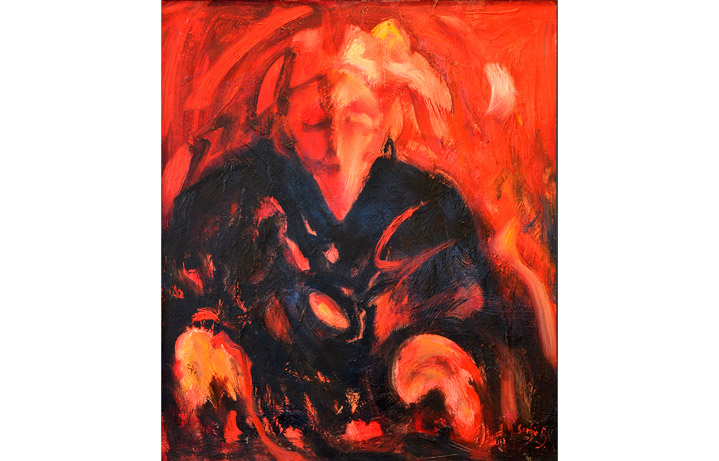
The passion of a jester
Technique: Oil painting on canvasDimensions: 23.6x27.5 inCritical signsSergio Boldrin Venice, a Place of the Soul
By Gabriella Niero
Colours incisively applied as dynamic segments turn the profiles of Venetian architectures into monumental façades. The spasmodic rhythm of the brush strokes shakes the giddy heights of the buildings with their dark windows, tracing the shaky profile of walls testifying to a remote and glorious past.
Spare surfaces waver against the sky. Beyond them is a glimpse of the void, giving a disquieting feel. A jester acts as a silent onlooker in this unusual urban context – a great mocking mask with a grotesque expression that follows Venice as it inexorably dissolves. This shift of colours is an immediately perceivable feature of Sergio Boldrin's painting. The viewer will be stunned and captivated by the artist's very personal take on the city, his city. There is no rhetoric here, no aesthetic complacency – only the genuineness of an enchanted place that is losing its historical reference points over time. Within this process of decline, Boldrin's art may be seen to express a sincere awareness, in the form of a mood, a poetic engagement which serves to interpret local malaise.
Urban architectures blend with one another and boldly intertwine on the surface of the paintings, creating vast monumental settings. It becomes difficult to detect any eastern styles or influences here, as all we can make out are mysterious, dream-like buildings which show an upside-down perspective in their interiors. It as if we were gazing at a vast papier mâché theatre resting on the fragile soil of the lagoon, gradually transcending it as it moves upwards. Like trees, the old palaces turn to the sky, stretching their roots for one last time towards the unstable surface they originated from.
Boldrin's painting, therefore, expresses a reality which emerges through observation, blending reason and feelings. His is a sophisticated research, which often crosses the threshold of dreams (or possibly nightmares), yet without ever losing touch with genuine reality. People who know and love Venice today see it as a melancholy city that has been stripped of its inhabitants, a city caught between its apparent existence and the soul which has made it so magnificent over time. Ruin, decay and the indifference of the majority speak of a lifeless city for Boldrin. Regrettably, Venice is losing not just its beauty, but also its identity. The jester's knowing gaze and his grotesque and melancholy mask conceal the conscious feelings of a Venetian. Painting manifestly becomes an intimate pursuit, a form of expressionism that is not merely formal, but which has been fully assimilated and redeveloped according to parameters based on complete emotional engagement – even of a visceral kind in certain paintings. The lines and visual impact of the subjects reveal a marked primitivism almost reminiscent of sculptures in the smoothness of the artist's fields of colour – as best illustrated by his melancholy white buffoon, with its stern and highly contemporary style.
The artist launches a sensory enquiry into the milieu of Venice by expressing visual impressions or extemporaneous images: in his pictorial rendering, he symbolically translates the reflections of known data by following the protean development of his subjects, the endless change of a decadent reflection on the lagoon. Refined and harmonious decorations give way to dense brush strokes; earth colours covered in blues simulate an architecture mottled by time; the shadows of an interior are depicted with dreamy melancholy. Boldrin thus attains his lyrical expression by structuring his images into various levels, using a different colour to define each phase. His images expand or grow denser from one level to the next. They mirror the reflections of an atmospheric crystal. They show the fleeting and precarious beauty of things. Possibly this is why the artist's brush strokes stand out like lacerations, congealing the veins of old marble as if they were deep wounds.
For Sergio Boldrin, each mark or colour influences his will to get to know the present dimension of an object, as if to seize control of its inner development. Painting here reveals the genuine identity of existence. Through a rhythm punctuated by gestural touches, the artist searches for that suspended moment which emerges as the genuine soul of the city. Meanwhile,the jester looks on, enabling the viewer to enter into direct communication with the artist and his reality: the arcane presence of the tragic mask envelops us in boundless pathos.
June 2012, Gabriella Niero
-
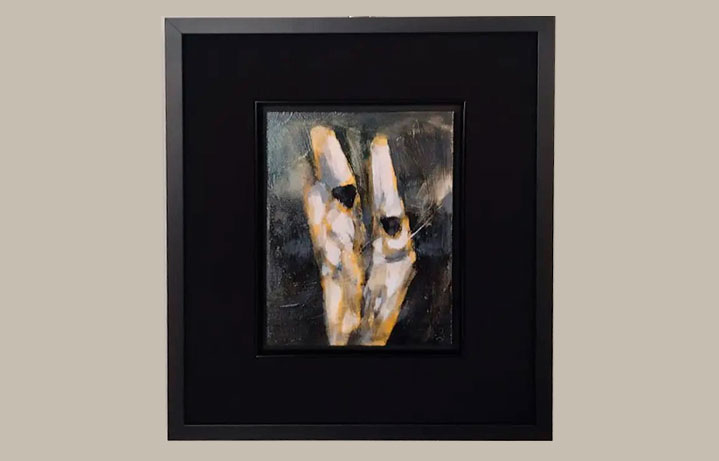
Pulcinella
-
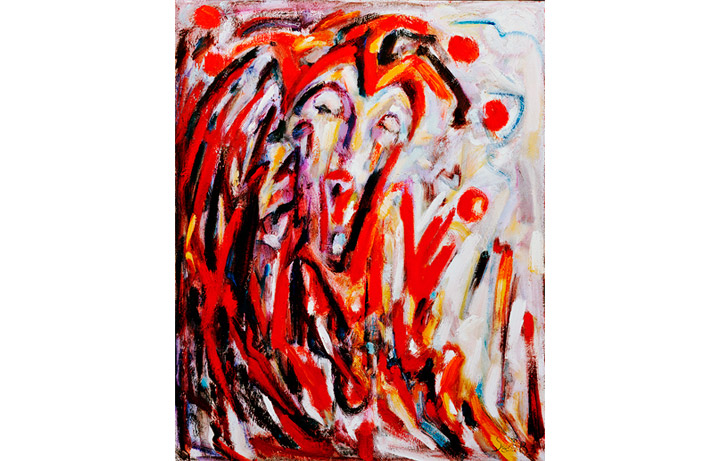
Jokerman (homage to Bob Dylan)
Technique: Oil painting on canvasDimensions: 27.5x39.4 inCritical signsSergio Boldrin Venice, a Place of the Soul
By Gabriella Niero
Colours incisively applied as dynamic segments turn the profiles of Venetian architectures into monumental façades. The spasmodic rhythm of the brush strokes shakes the giddy heights of the buildings with their dark windows, tracing the shaky profile of walls testifying to a remote and glorious past.
Spare surfaces waver against the sky. Beyond them is a glimpse of the void, giving a disquieting feel. A jester acts as a silent onlooker in this unusual urban context – a great mocking mask with a grotesque expression that follows Venice as it inexorably dissolves. This shift of colours is an immediately perceivable feature of Sergio Boldrin's painting. The viewer will be stunned and captivated by the artist's very personal take on the city, his city. There is no rhetoric here, no aesthetic complacency – only the genuineness of an enchanted place that is losing its historical reference points over time. Within this process of decline, Boldrin's art may be seen to express a sincere awareness, in the form of a mood, a poetic engagement which serves to interpret local malaise.
Urban architectures blend with one another and boldly intertwine on the surface of the paintings, creating vast monumental settings. It becomes difficult to detect any eastern styles or influences here, as all we can make out are mysterious, dream-like buildings which show an upside-down perspective in their interiors. It as if we were gazing at a vast papier mâché theatre resting on the fragile soil of the lagoon, gradually transcending it as it moves upwards. Like trees, the old palaces turn to the sky, stretching their roots for one last time towards the unstable surface they originated from.
Boldrin's painting, therefore, expresses a reality which emerges through observation, blending reason and feelings. His is a sophisticated research, which often crosses the threshold of dreams (or possibly nightmares), yet without ever losing touch with genuine reality. People who know and love Venice today see it as a melancholy city that has been stripped of its inhabitants, a city caught between its apparent existence and the soul which has made it so magnificent over time. Ruin, decay and the indifference of the majority speak of a lifeless city for Boldrin. Regrettably, Venice is losing not just its beauty, but also its identity. The jester's knowing gaze and his grotesque and melancholy mask conceal the conscious feelings of a Venetian. Painting manifestly becomes an intimate pursuit, a form of expressionism that is not merely formal, but which has been fully assimilated and redeveloped according to parameters based on complete emotional engagement – even of a visceral kind in certain paintings. The lines and visual impact of the subjects reveal a marked primitivism almost reminiscent of sculptures in the smoothness of the artist's fields of colour – as best illustrated by his melancholy white buffoon, with its stern and highly contemporary style.
The artist launches a sensory enquiry into the milieu of Venice by expressing visual impressions or extemporaneous images: in his pictorial rendering, he symbolically translates the reflections of known data by following the protean development of his subjects, the endless change of a decadent reflection on the lagoon. Refined and harmonious decorations give way to dense brush strokes; earth colours covered in blues simulate an architecture mottled by time; the shadows of an interior are depicted with dreamy melancholy. Boldrin thus attains his lyrical expression by structuring his images into various levels, using a different colour to define each phase. His images expand or grow denser from one level to the next. They mirror the reflections of an atmospheric crystal. They show the fleeting and precarious beauty of things. Possibly this is why the artist's brush strokes stand out like lacerations, congealing the veins of old marble as if they were deep wounds.
For Sergio Boldrin, each mark or colour influences his will to get to know the present dimension of an object, as if to seize control of its inner development. Painting here reveals the genuine identity of existence. Through a rhythm punctuated by gestural touches, the artist searches for that suspended moment which emerges as the genuine soul of the city. Meanwhile,the jester looks on, enabling the viewer to enter into direct communication with the artist and his reality: the arcane presence of the tragic mask envelops us in boundless pathos.
June 2012, Gabriella Niero
-
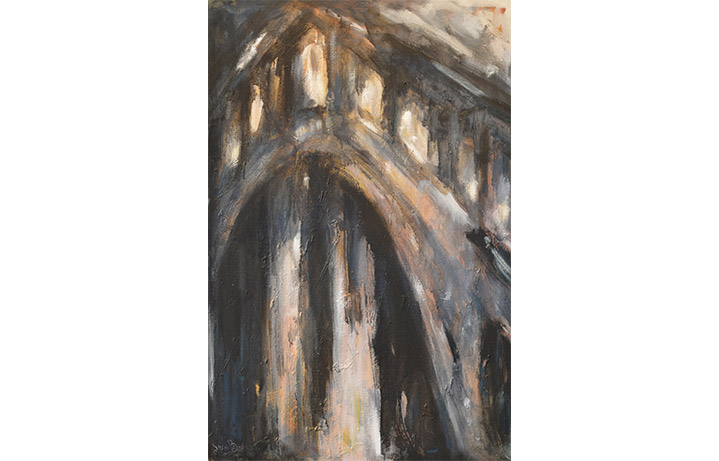
Rialto
Technique: Oil painting on canvasDimensions: 23.6x35.4 inCritical signsSergio Boldrin Venice, a Place of the Soul
By Gabriella Niero
Colours incisively applied as dynamic segments turn the profiles of Venetian architectures into monumental façades. The spasmodic rhythm of the brush strokes shakes the giddy heights of the buildings with their dark windows, tracing the shaky profile of walls testifying to a remote and glorious past.
Spare surfaces waver against the sky. Beyond them is a glimpse of the void, giving a disquieting feel. A jester acts as a silent onlooker in this unusual urban context – a great mocking mask with a grotesque expression that follows Venice as it inexorably dissolves. This shift of colours is an immediately perceivable feature of Sergio Boldrin's painting. The viewer will be stunned and captivated by the artist's very personal take on the city, his city. There is no rhetoric here, no aesthetic complacency – only the genuineness of an enchanted place that is losing its historical reference points over time. Within this process of decline, Boldrin's art may be seen to express a sincere awareness, in the form of a mood, a poetic engagement which serves to interpret local malaise.
Urban architectures blend with one another and boldly intertwine on the surface of the paintings, creating vast monumental settings. It becomes difficult to detect any eastern styles or influences here, as all we can make out are mysterious, dream-like buildings which show an upside-down perspective in their interiors. It as if we were gazing at a vast papier mâché theatre resting on the fragile soil of the lagoon, gradually transcending it as it moves upwards. Like trees, the old palaces turn to the sky, stretching their roots for one last time towards the unstable surface they originated from.
Boldrin's painting, therefore, expresses a reality which emerges through observation, blending reason and feelings. His is a sophisticated research, which often crosses the threshold of dreams (or possibly nightmares), yet without ever losing touch with genuine reality. People who know and love Venice today see it as a melancholy city that has been stripped of its inhabitants, a city caught between its apparent existence and the soul which has made it so magnificent over time. Ruin, decay and the indifference of the majority speak of a lifeless city for Boldrin. Regrettably, Venice is losing not just its beauty, but also its identity. The jester's knowing gaze and his grotesque and melancholy mask conceal the conscious feelings of a Venetian. Painting manifestly becomes an intimate pursuit, a form of expressionism that is not merely formal, but which has been fully assimilated and redeveloped according to parameters based on complete emotional engagement – even of a visceral kind in certain paintings. The lines and visual impact of the subjects reveal a marked primitivism almost reminiscent of sculptures in the smoothness of the artist's fields of colour – as best illustrated by his melancholy white buffoon, with its stern and highly contemporary style.
The artist launches a sensory enquiry into the milieu of Venice by expressing visual impressions or extemporaneous images: in his pictorial rendering, he symbolically translates the reflections of known data by following the protean development of his subjects, the endless change of a decadent reflection on the lagoon. Refined and harmonious decorations give way to dense brush strokes; earth colours covered in blues simulate an architecture mottled by time; the shadows of an interior are depicted with dreamy melancholy. Boldrin thus attains his lyrical expression by structuring his images into various levels, using a different colour to define each phase. His images expand or grow denser from one level to the next. They mirror the reflections of an atmospheric crystal. They show the fleeting and precarious beauty of things. Possibly this is why the artist's brush strokes stand out like lacerations, congealing the veins of old marble as if they were deep wounds.
For Sergio Boldrin, each mark or colour influences his will to get to know the present dimension of an object, as if to seize control of its inner development. Painting here reveals the genuine identity of existence. Through a rhythm punctuated by gestural touches, the artist searches for that suspended moment which emerges as the genuine soul of the city. Meanwhile,the jester looks on, enabling the viewer to enter into direct communication with the artist and his reality: the arcane presence of the tragic mask envelops us in boundless pathos.
June 2012, Gabriella Niero
-
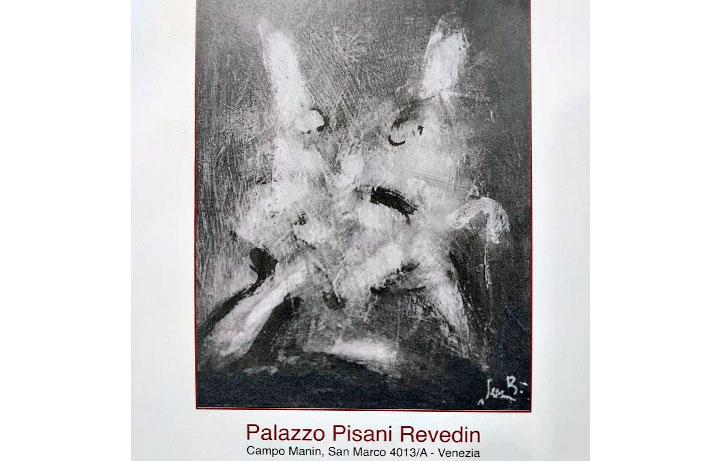
Pulcinella
-
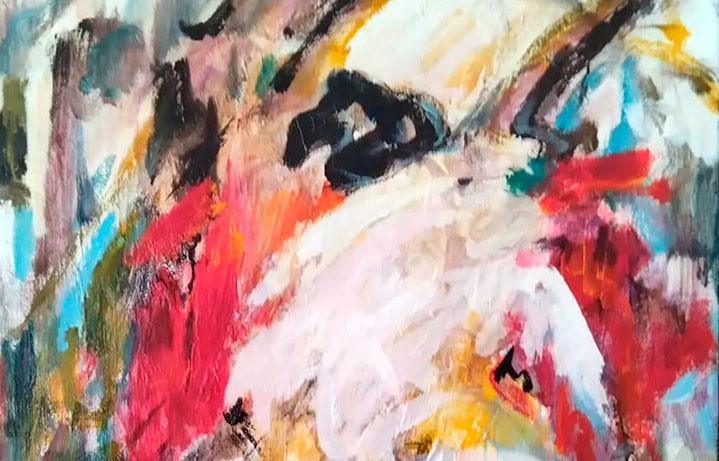
Pulcinella
-
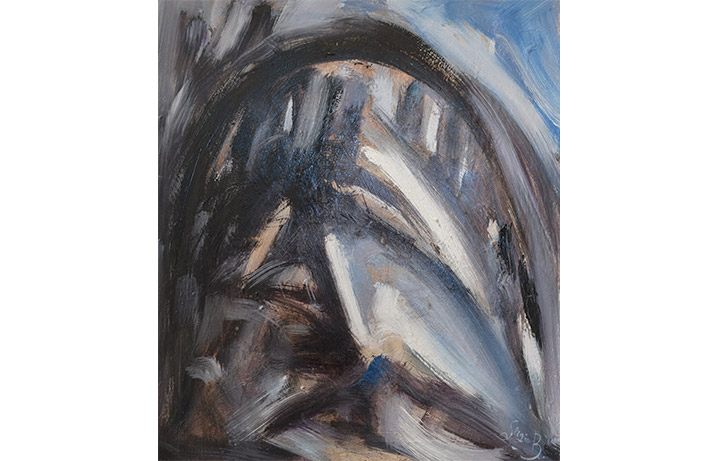
Under a bridge
Technique: Oil painting on canvasDimensions: 13.7x15.7 inCritical signsSergio Boldrin Venice, a Place of the Soul
By Gabriella Niero
Colours incisively applied as dynamic segments turn the profiles of Venetian architectures into monumental façades. The spasmodic rhythm of the brush strokes shakes the giddy heights of the buildings with their dark windows, tracing the shaky profile of walls testifying to a remote and glorious past.
Spare surfaces waver against the sky. Beyond them is a glimpse of the void, giving a disquieting feel. A jester acts as a silent onlooker in this unusual urban context – a great mocking mask with a grotesque expression that follows Venice as it inexorably dissolves. This shift of colours is an immediately perceivable feature of Sergio Boldrin's painting. The viewer will be stunned and captivated by the artist's very personal take on the city, his city. There is no rhetoric here, no aesthetic complacency – only the genuineness of an enchanted place that is losing its historical reference points over time. Within this process of decline, Boldrin's art may be seen to express a sincere awareness, in the form of a mood, a poetic engagement which serves to interpret local malaise.
Urban architectures blend with one another and boldly intertwine on the surface of the paintings, creating vast monumental settings. It becomes difficult to detect any eastern styles or influences here, as all we can make out are mysterious, dream-like buildings which show an upside-down perspective in their interiors. It as if we were gazing at a vast papier mâché theatre resting on the fragile soil of the lagoon, gradually transcending it as it moves upwards. Like trees, the old palaces turn to the sky, stretching their roots for one last time towards the unstable surface they originated from.
Boldrin's painting, therefore, expresses a reality which emerges through observation, blending reason and feelings. His is a sophisticated research, which often crosses the threshold of dreams (or possibly nightmares), yet without ever losing touch with genuine reality. People who know and love Venice today see it as a melancholy city that has been stripped of its inhabitants, a city caught between its apparent existence and the soul which has made it so magnificent over time. Ruin, decay and the indifference of the majority speak of a lifeless city for Boldrin. Regrettably, Venice is losing not just its beauty, but also its identity. The jester's knowing gaze and his grotesque and melancholy mask conceal the conscious feelings of a Venetian. Painting manifestly becomes an intimate pursuit, a form of expressionism that is not merely formal, but which has been fully assimilated and redeveloped according to parameters based on complete emotional engagement – even of a visceral kind in certain paintings. The lines and visual impact of the subjects reveal a marked primitivism almost reminiscent of sculptures in the smoothness of the artist's fields of colour – as best illustrated by his melancholy white buffoon, with its stern and highly contemporary style.
The artist launches a sensory enquiry into the milieu of Venice by expressing visual impressions or extemporaneous images: in his pictorial rendering, he symbolically translates the reflections of known data by following the protean development of his subjects, the endless change of a decadent reflection on the lagoon. Refined and harmonious decorations give way to dense brush strokes; earth colours covered in blues simulate an architecture mottled by time; the shadows of an interior are depicted with dreamy melancholy. Boldrin thus attains his lyrical expression by structuring his images into various levels, using a different colour to define each phase. His images expand or grow denser from one level to the next. They mirror the reflections of an atmospheric crystal. They show the fleeting and precarious beauty of things. Possibly this is why the artist's brush strokes stand out like lacerations, congealing the veins of old marble as if they were deep wounds.
For Sergio Boldrin, each mark or colour influences his will to get to know the present dimension of an object, as if to seize control of its inner development. Painting here reveals the genuine identity of existence. Through a rhythm punctuated by gestural touches, the artist searches for that suspended moment which emerges as the genuine soul of the city. Meanwhile,the jester looks on, enabling the viewer to enter into direct communication with the artist and his reality: the arcane presence of the tragic mask envelops us in boundless pathos.
June 2012, Gabriella Niero
-
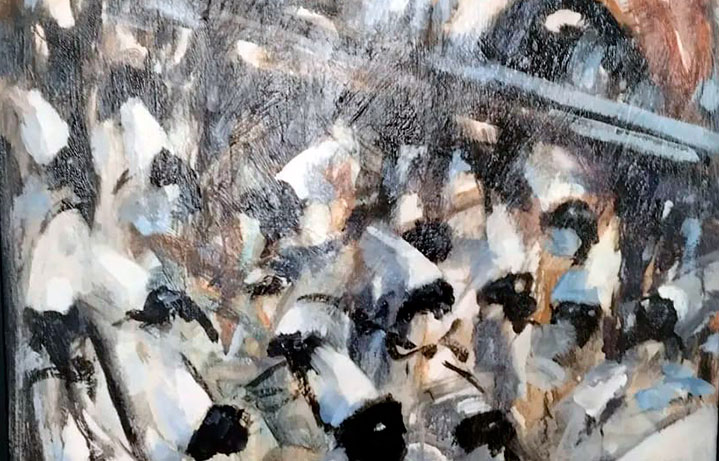
Pulcinella
-
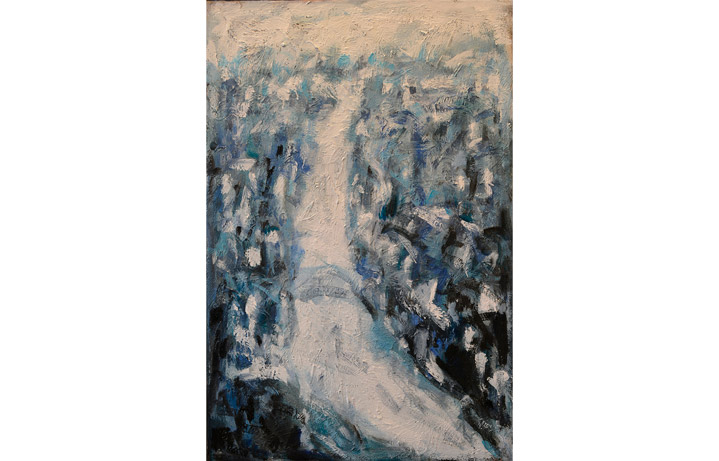
Grand Canal
Technique: Oil painting on canvasDimensions: 23.6x35.4 inCritical signsSergio Boldrin Blue Period
The artist’s attempt to take possession of blue to remain suspended, but in a state of emotional balance, to face all the emotions of this particular moment in time, using overseas, cobalt; to enter as a mysterious pictorial sign in a canvas – White day – and as a result moving away from his usual common rigorous palette, the scene remains the same, not an act of surrender but an attempt to express silence, mysterious tranquility, remaining as in a suspended dream, using blue as a equilibrist uses his pole over the rope.
-
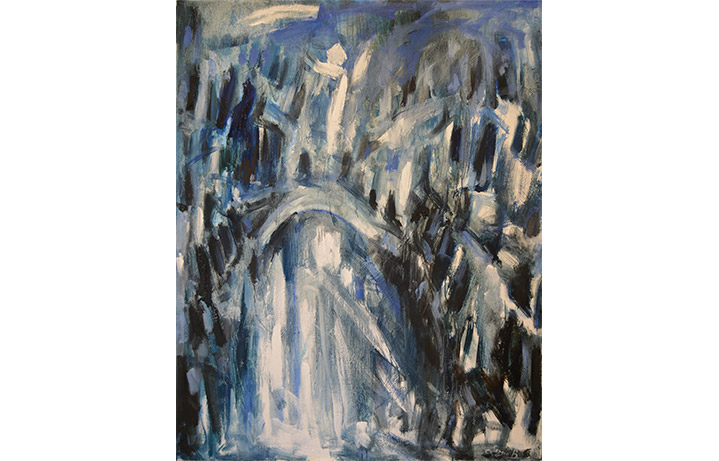
Dancing Canal
Technique: Oil painting on canvasDimensions: 31.4x39.4 inCritical signsSergio Boldrin Blue Period
The artist’s attempt to take possession of blue to remain suspended, but in a state of emotional balance, to face all the emotions of this particular moment in time, using overseas, cobalt; to enter as a mysterious pictorial sign in a canvas – White day – and as a result moving away from his usual common rigorous palette, the scene remains the same, not an act of surrender but an attempt to express silence, mysterious tranquility, remaining as in a suspended dream, using blue as a equilibrist uses his pole over the rope.
-
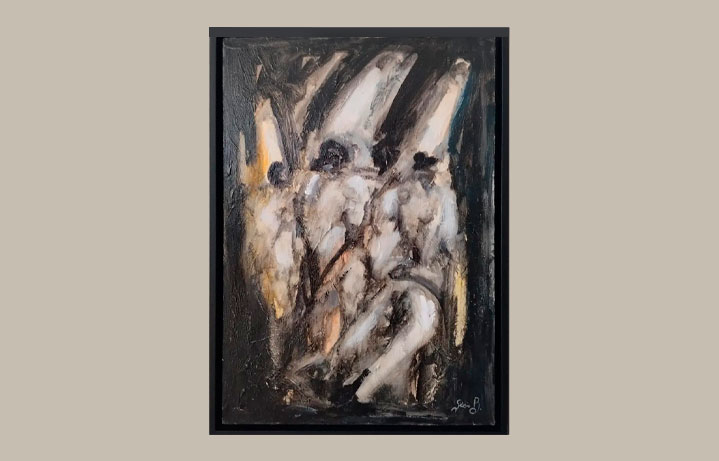
Pulcinella
-
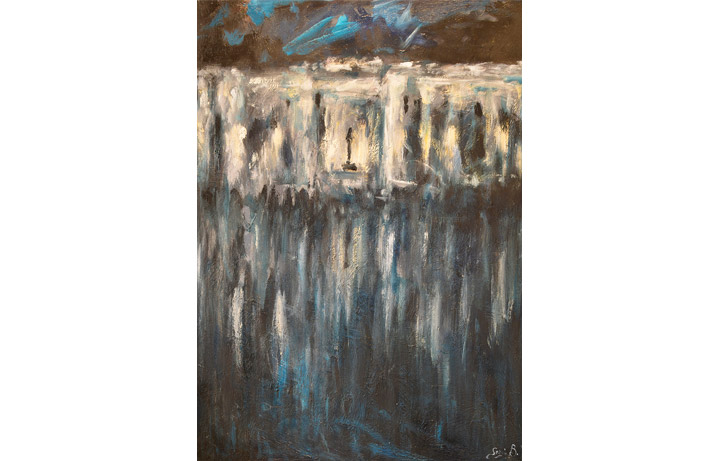
Light up of art (Guggenheim)
Technique: Oil painting on canvasDimensions: 27.5x39.4 inCritical signsSergio Boldrin Blue Period
The artist’s attempt to take possession of blue to remain suspended, but in a state of emotional balance, to face all the emotions of this particular moment in time, using overseas, cobalt; to enter as a mysterious pictorial sign in a canvas – White day – and as a result moving away from his usual common rigorous palette, the scene remains the same, not an act of surrender but an attempt to express silence, mysterious tranquility, remaining as in a suspended dream, using blue as a equilibrist uses his pole over the rope.
-
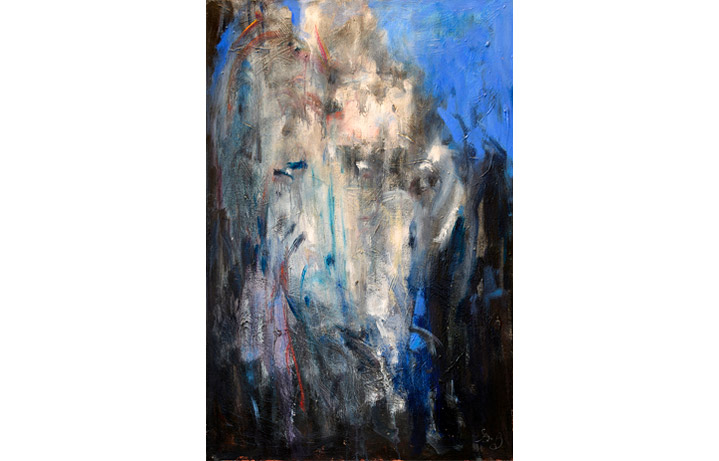
Night mystery
Technique: Oil painting on canvasDimensions: 23.6x35.4 inCritical signsSergio Boldrin Blue Period
The artist’s attempt to take possession of blue to remain suspended, but in a state of emotional balance, to face all the emotions of this particular moment in time, using overseas, cobalt; to enter as a mysterious pictorial sign in a canvas – White day – and as a result moving away from his usual common rigorous palette, the scene remains the same, not an act of surrender but an attempt to express silence, mysterious tranquility, remaining as in a suspended dream, using blue as a equilibrist uses his pole over the rope.
-
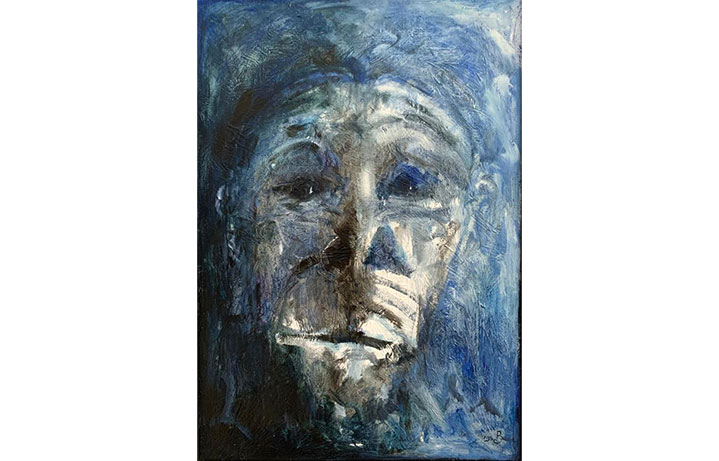
Untitled
Technique: Oil painting on canvas Dimensions: 80x100cmSoldCenni criticiSergio Boldrin Blue Period
The artist’s attempt to take possession of blue to remain suspended, but in a state of emotional balance, to face all the emotions of this particular moment in time, using overseas, cobalt; to enter as a mysterious pictorial sign in a canvas – White day – and as a result moving away from his usual common rigorous palette, the scene remains the same, not an act of surrender but an attempt to express silence, mysterious tranquility, remaining as in a suspended dream, using blue as a equilibrist uses his pole over the rope.
-
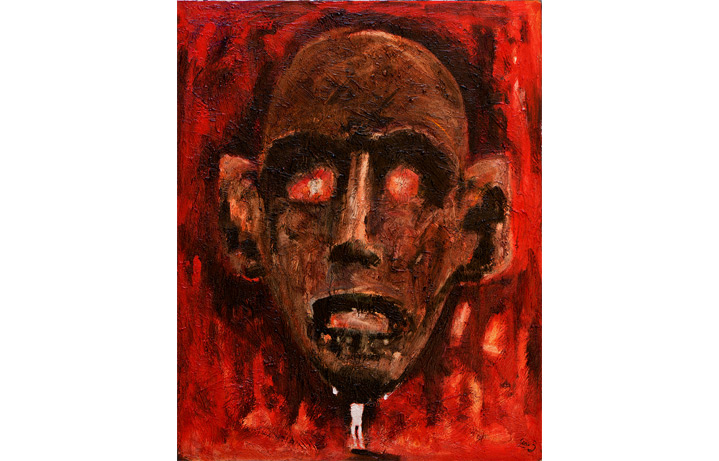
La prima maschera
Technique: Mixed technique on canvasDimensions: 80x100cm2021Critical signsSergio BoldrinFirst Mask
Men and their masks, an inseparable whole, take on a leading role in the new pictorial cycle of the Venetian artist Sergio Boldrin.
The artist's proposal is an emotionally-charged pictorial reflection which, like a "slap," leads to the primordial being, thoroughly exploring its most intrinsic nature.
Such exploration, however, aims to stress men's figure rather than the mask, leaving to the latter the major task of revealing men's most obscure traits while uncovering their true identity.
Boldrin, while drawing on his enormous knowledge as a master "mascarer," a constant cause for reflection for him, managed as a painter to escape from the heap of masks that accompany his every day, succeeding in unearthing the mask's meaning for the deepest self which any human has faced since the dawn of time.
In this selection of pictorial works, in fact, the mask is not intended in the theatrical terms of the "Commedia dell'Arte" or those of Carnival, but in an intimate and spiritual way, and is seen mainly in its innate appearance as a primordial face: men, the very moment they open their eyes to the world, receive a mask they will wear to their grave.
Referring to this concept, Boldrin drew inspiration from African masks to create his works. Other artists had already taken them as a point of reference in the past, in particular various exponents of Cubism, Fauvism and Expressionism in the avant-garde period of the twentieth century.
Boldrin's vision is nonetheless entirely new and, in a strikingly original conceptual and artistic approach, invites us to look back at the early fusion of men and mask that – erected as symbols – infuse the traits of each mortal. In particular, to underline the duality of a psychological component, Boldrin refers to the anonymous work "Mask of Zaire" kept at the Royal Museum of Central Africa, from which Picasso already drew inspiration – although with a primarily geometric interest – to realise "Les Demoiselles D’Avignon."
In his works, Boldrin depicts each new-born being entrusted with a mask as a small, white figure in embryonic and evanescent form, the symbol of a pure and authentic soul at the beginning of a new life. This figure holds up the great mask ready to wear it, with ever-changing gestures, with graceful and fluttering characters, never completely defined.
Boldrin, indeed, represents diverse "natives," each poised to be unique as regards their physiognomic, psychological, personality, and behavioural features.
There are masks overtly possessed by a demonic stance, conveyed through the warm pigments of the scarlet and blood red, and whose fiery eyes express the yearnings of a tormented and tormenting soul. Others, with darker hues, full of melancholy and mystery, recall signs of suffering, struggle and war. There are some in which the idea of a more serene soul devoted to reflection and analysis prevails, while others have a dreamier inclination and connect with a dancing and philosophical world. And again, masks with earthly colours – which appear more goliardic – recall pastoral and bucolic scenes.
These works present a strong figurative component which is aptly combined with the most abstract part, reminiscent of dreams and imagination. At times, the space becomes nearly theatrical, while other times the background turns largely abstract and adorned with psychological connotations. If masks on certain works show a marked, largely geometric structure, others merge with the being behind them to the point of adopting more human traits, as if they were a second skin.
Finally, the last work, on an almost black purple background, recovers the first mask of the exhibition which now – repainted in white – offers a ghostly appearance.
This work represents the end of life, the last moment men will wear their mask and in which both will cancel out.
A reflection that is narrated in works characterised by gestural instinct and intelligent tone calibration, between contrasts designed to emphasise sensations and moods, in colours as intense as life itself.
Francesca Catalano - Art critic and curator
-
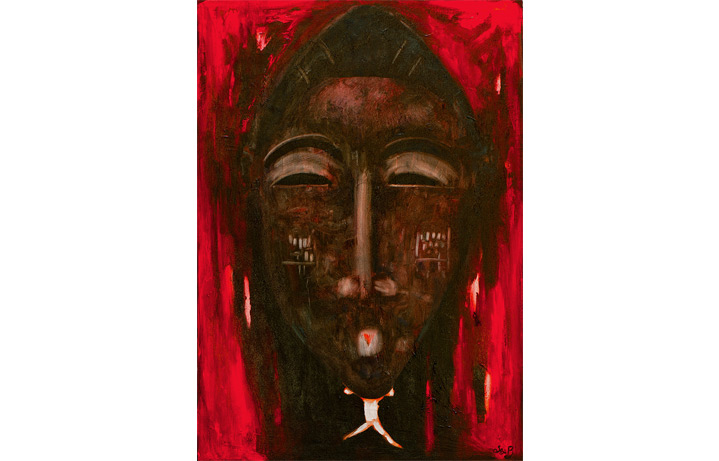
Nativo 2
Technique: Oil painting on canvas Dimensions: 70x100cm2021Critical signsSergio BoldrinFirst Mask
Men and their masks, an inseparable whole, take on a leading role in the new pictorial cycle of the Venetian artist Sergio Boldrin.
The artist's proposal is an emotionally-charged pictorial reflection which, like a "slap," leads to the primordial being, thoroughly exploring its most intrinsic nature.
Such exploration, however, aims to stress men's figure rather than the mask, leaving to the latter the major task of revealing men's most obscure traits while uncovering their true identity.
Boldrin, while drawing on his enormous knowledge as a master "mascarer," a constant cause for reflection for him, managed as a painter to escape from the heap of masks that accompany his every day, succeeding in unearthing the mask's meaning for the deepest self which any human has faced since the dawn of time.
In this selection of pictorial works, in fact, the mask is not intended in the theatrical terms of the "Commedia dell'Arte" or those of Carnival, but in an intimate and spiritual way, and is seen mainly in its innate appearance as a primordial face: men, the very moment they open their eyes to the world, receive a mask they will wear to their grave.
Referring to this concept, Boldrin drew inspiration from African masks to create his works. Other artists had already taken them as a point of reference in the past, in particular various exponents of Cubism, Fauvism and Expressionism in the avant-garde period of the twentieth century.
Boldrin's vision is nonetheless entirely new and, in a strikingly original conceptual and artistic approach, invites us to look back at the early fusion of men and mask that – erected as symbols – infuse the traits of each mortal. In particular, to underline the duality of a psychological component, Boldrin refers to the anonymous work "Mask of Zaire" kept at the Royal Museum of Central Africa, from which Picasso already drew inspiration – although with a primarily geometric interest – to realise "Les Demoiselles D’Avignon."
In his works, Boldrin depicts each new-born being entrusted with a mask as a small, white figure in embryonic and evanescent form, the symbol of a pure and authentic soul at the beginning of a new life. This figure holds up the great mask ready to wear it, with ever-changing gestures, with graceful and fluttering characters, never completely defined.
Boldrin, indeed, represents diverse "natives," each poised to be unique as regards their physiognomic, psychological, personality, and behavioural features.
There are masks overtly possessed by a demonic stance, conveyed through the warm pigments of the scarlet and blood red, and whose fiery eyes express the yearnings of a tormented and tormenting soul. Others, with darker hues, full of melancholy and mystery, recall signs of suffering, struggle and war. There are some in which the idea of a more serene soul devoted to reflection and analysis prevails, while others have a dreamier inclination and connect with a dancing and philosophical world. And again, masks with earthly colours – which appear more goliardic – recall pastoral and bucolic scenes.
These works present a strong figurative component which is aptly combined with the most abstract part, reminiscent of dreams and imagination. At times, the space becomes nearly theatrical, while other times the background turns largely abstract and adorned with psychological connotations. If masks on certain works show a marked, largely geometric structure, others merge with the being behind them to the point of adopting more human traits, as if they were a second skin.
Finally, the last work, on an almost black purple background, recovers the first mask of the exhibition which now – repainted in white – offers a ghostly appearance.
This work represents the end of life, the last moment men will wear their mask and in which both will cancel out.
A reflection that is narrated in works characterised by gestural instinct and intelligent tone calibration, between contrasts designed to emphasise sensations and moods, in colours as intense as life itself.
Francesca Catalano - Art critic and curator
-
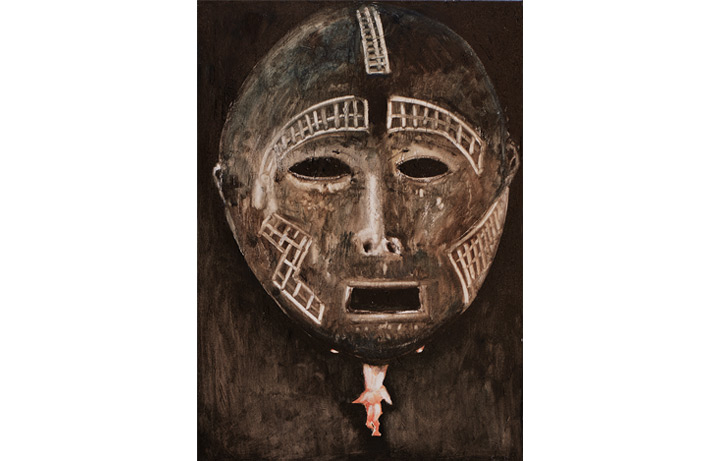
Nativo 3
Technique: Oil painting on canvas Dimensions: 70x100cm2021Critical signsSergio BoldrinFirst Mask
Men and their masks, an inseparable whole, take on a leading role in the new pictorial cycle of the Venetian artist Sergio Boldrin.
The artist's proposal is an emotionally-charged pictorial reflection which, like a "slap," leads to the primordial being, thoroughly exploring its most intrinsic nature.
Such exploration, however, aims to stress men's figure rather than the mask, leaving to the latter the major task of revealing men's most obscure traits while uncovering their true identity.
Boldrin, while drawing on his enormous knowledge as a master "mascarer," a constant cause for reflection for him, managed as a painter to escape from the heap of masks that accompany his every day, succeeding in unearthing the mask's meaning for the deepest self which any human has faced since the dawn of time.
In this selection of pictorial works, in fact, the mask is not intended in the theatrical terms of the "Commedia dell'Arte" or those of Carnival, but in an intimate and spiritual way, and is seen mainly in its innate appearance as a primordial face: men, the very moment they open their eyes to the world, receive a mask they will wear to their grave.
Referring to this concept, Boldrin drew inspiration from African masks to create his works. Other artists had already taken them as a point of reference in the past, in particular various exponents of Cubism, Fauvism and Expressionism in the avant-garde period of the twentieth century.
Boldrin's vision is nonetheless entirely new and, in a strikingly original conceptual and artistic approach, invites us to look back at the early fusion of men and mask that – erected as symbols – infuse the traits of each mortal. In particular, to underline the duality of a psychological component, Boldrin refers to the anonymous work "Mask of Zaire" kept at the Royal Museum of Central Africa, from which Picasso already drew inspiration – although with a primarily geometric interest – to realise "Les Demoiselles D’Avignon."
In his works, Boldrin depicts each new-born being entrusted with a mask as a small, white figure in embryonic and evanescent form, the symbol of a pure and authentic soul at the beginning of a new life. This figure holds up the great mask ready to wear it, with ever-changing gestures, with graceful and fluttering characters, never completely defined.
Boldrin, indeed, represents diverse "natives," each poised to be unique as regards their physiognomic, psychological, personality, and behavioural features.
There are masks overtly possessed by a demonic stance, conveyed through the warm pigments of the scarlet and blood red, and whose fiery eyes express the yearnings of a tormented and tormenting soul. Others, with darker hues, full of melancholy and mystery, recall signs of suffering, struggle and war. There are some in which the idea of a more serene soul devoted to reflection and analysis prevails, while others have a dreamier inclination and connect with a dancing and philosophical world. And again, masks with earthly colours – which appear more goliardic – recall pastoral and bucolic scenes.
These works present a strong figurative component which is aptly combined with the most abstract part, reminiscent of dreams and imagination. At times, the space becomes nearly theatrical, while other times the background turns largely abstract and adorned with psychological connotations. If masks on certain works show a marked, largely geometric structure, others merge with the being behind them to the point of adopting more human traits, as if they were a second skin.
Finally, the last work, on an almost black purple background, recovers the first mask of the exhibition which now – repainted in white – offers a ghostly appearance.
This work represents the end of life, the last moment men will wear their mask and in which both will cancel out.
A reflection that is narrated in works characterised by gestural instinct and intelligent tone calibration, between contrasts designed to emphasise sensations and moods, in colours as intense as life itself.
Francesca Catalano - Art critic and curator
-
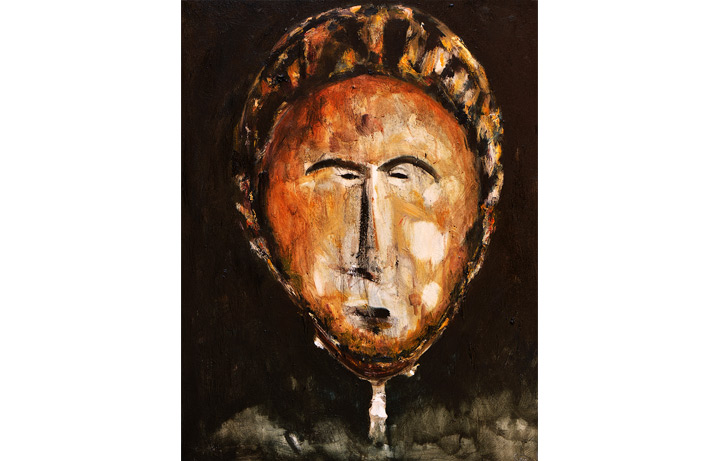
Nativo 4
Technique: Oil painting on canvas Dimensions: 50x70cm2021Critical signsSergio BoldrinFirst Mask
Men and their masks, an inseparable whole, take on a leading role in the new pictorial cycle of the Venetian artist Sergio Boldrin.
The artist's proposal is an emotionally-charged pictorial reflection which, like a "slap," leads to the primordial being, thoroughly exploring its most intrinsic nature.
Such exploration, however, aims to stress men's figure rather than the mask, leaving to the latter the major task of revealing men's most obscure traits while uncovering their true identity.
Boldrin, while drawing on his enormous knowledge as a master "mascarer," a constant cause for reflection for him, managed as a painter to escape from the heap of masks that accompany his every day, succeeding in unearthing the mask's meaning for the deepest self which any human has faced since the dawn of time.
In this selection of pictorial works, in fact, the mask is not intended in the theatrical terms of the "Commedia dell'Arte" or those of Carnival, but in an intimate and spiritual way, and is seen mainly in its innate appearance as a primordial face: men, the very moment they open their eyes to the world, receive a mask they will wear to their grave.
Referring to this concept, Boldrin drew inspiration from African masks to create his works. Other artists had already taken them as a point of reference in the past, in particular various exponents of Cubism, Fauvism and Expressionism in the avant-garde period of the twentieth century.
Boldrin's vision is nonetheless entirely new and, in a strikingly original conceptual and artistic approach, invites us to look back at the early fusion of men and mask that – erected as symbols – infuse the traits of each mortal. In particular, to underline the duality of a psychological component, Boldrin refers to the anonymous work "Mask of Zaire" kept at the Royal Museum of Central Africa, from which Picasso already drew inspiration – although with a primarily geometric interest – to realise "Les Demoiselles D’Avignon."
In his works, Boldrin depicts each new-born being entrusted with a mask as a small, white figure in embryonic and evanescent form, the symbol of a pure and authentic soul at the beginning of a new life. This figure holds up the great mask ready to wear it, with ever-changing gestures, with graceful and fluttering characters, never completely defined.
Boldrin, indeed, represents diverse "natives," each poised to be unique as regards their physiognomic, psychological, personality, and behavioural features.
There are masks overtly possessed by a demonic stance, conveyed through the warm pigments of the scarlet and blood red, and whose fiery eyes express the yearnings of a tormented and tormenting soul. Others, with darker hues, full of melancholy and mystery, recall signs of suffering, struggle and war. There are some in which the idea of a more serene soul devoted to reflection and analysis prevails, while others have a dreamier inclination and connect with a dancing and philosophical world. And again, masks with earthly colours – which appear more goliardic – recall pastoral and bucolic scenes.
These works present a strong figurative component which is aptly combined with the most abstract part, reminiscent of dreams and imagination. At times, the space becomes nearly theatrical, while other times the background turns largely abstract and adorned with psychological connotations. If masks on certain works show a marked, largely geometric structure, others merge with the being behind them to the point of adopting more human traits, as if they were a second skin.
Finally, the last work, on an almost black purple background, recovers the first mask of the exhibition which now – repainted in white – offers a ghostly appearance.
This work represents the end of life, the last moment men will wear their mask and in which both will cancel out.
A reflection that is narrated in works characterised by gestural instinct and intelligent tone calibration, between contrasts designed to emphasise sensations and moods, in colours as intense as life itself.
Francesca Catalano - Art critic and curator
-
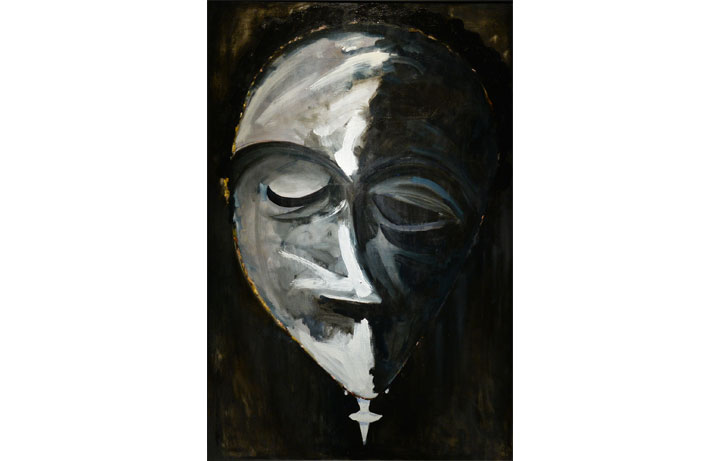
Nativo 6
Technique: Oil painting on canvas Dimensions: 80x120cm2022Critical signsSergio BoldrinFirst Mask
Men and their masks, an inseparable whole, take on a leading role in the new pictorial cycle of the Venetian artist Sergio Boldrin.
The artist's proposal is an emotionally-charged pictorial reflection which, like a "slap," leads to the primordial being, thoroughly exploring its most intrinsic nature.
Such exploration, however, aims to stress men's figure rather than the mask, leaving to the latter the major task of revealing men's most obscure traits while uncovering their true identity.
Boldrin, while drawing on his enormous knowledge as a master "mascarer," a constant cause for reflection for him, managed as a painter to escape from the heap of masks that accompany his every day, succeeding in unearthing the mask's meaning for the deepest self which any human has faced since the dawn of time.
In this selection of pictorial works, in fact, the mask is not intended in the theatrical terms of the "Commedia dell'Arte" or those of Carnival, but in an intimate and spiritual way, and is seen mainly in its innate appearance as a primordial face: men, the very moment they open their eyes to the world, receive a mask they will wear to their grave.
Referring to this concept, Boldrin drew inspiration from African masks to create his works. Other artists had already taken them as a point of reference in the past, in particular various exponents of Cubism, Fauvism and Expressionism in the avant-garde period of the twentieth century.
Boldrin's vision is nonetheless entirely new and, in a strikingly original conceptual and artistic approach, invites us to look back at the early fusion of men and mask that – erected as symbols – infuse the traits of each mortal. In particular, to underline the duality of a psychological component, Boldrin refers to the anonymous work "Mask of Zaire" kept at the Royal Museum of Central Africa, from which Picasso already drew inspiration – although with a primarily geometric interest – to realise "Les Demoiselles D’Avignon."
In his works, Boldrin depicts each new-born being entrusted with a mask as a small, white figure in embryonic and evanescent form, the symbol of a pure and authentic soul at the beginning of a new life. This figure holds up the great mask ready to wear it, with ever-changing gestures, with graceful and fluttering characters, never completely defined.
Boldrin, indeed, represents diverse "natives," each poised to be unique as regards their physiognomic, psychological, personality, and behavioural features.
There are masks overtly possessed by a demonic stance, conveyed through the warm pigments of the scarlet and blood red, and whose fiery eyes express the yearnings of a tormented and tormenting soul. Others, with darker hues, full of melancholy and mystery, recall signs of suffering, struggle and war. There are some in which the idea of a more serene soul devoted to reflection and analysis prevails, while others have a dreamier inclination and connect with a dancing and philosophical world. And again, masks with earthly colours – which appear more goliardic – recall pastoral and bucolic scenes.
These works present a strong figurative component which is aptly combined with the most abstract part, reminiscent of dreams and imagination. At times, the space becomes nearly theatrical, while other times the background turns largely abstract and adorned with psychological connotations. If masks on certain works show a marked, largely geometric structure, others merge with the being behind them to the point of adopting more human traits, as if they were a second skin.
Finally, the last work, on an almost black purple background, recovers the first mask of the exhibition which now – repainted in white – offers a ghostly appearance.
This work represents the end of life, the last moment men will wear their mask and in which both will cancel out.
A reflection that is narrated in works characterised by gestural instinct and intelligent tone calibration, between contrasts designed to emphasise sensations and moods, in colours as intense as life itself.
Francesca Catalano - Art critic and curator
-
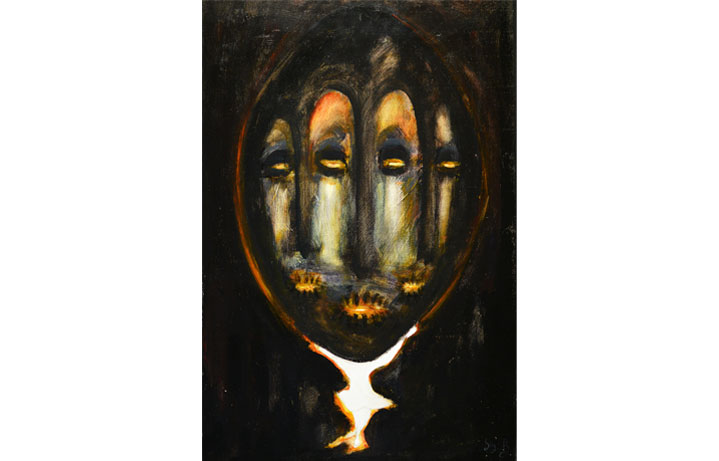
Nativo 8
Technique: Oil on the tableDimensions: 40x60cm2022Critical signsSergio BoldrinFirst Mask
Men and their masks, an inseparable whole, take on a leading role in the new pictorial cycle of the Venetian artist Sergio Boldrin.
The artist's proposal is an emotionally-charged pictorial reflection which, like a "slap," leads to the primordial being, thoroughly exploring its most intrinsic nature.
Such exploration, however, aims to stress men's figure rather than the mask, leaving to the latter the major task of revealing men's most obscure traits while uncovering their true identity.
Boldrin, while drawing on his enormous knowledge as a master "mascarer," a constant cause for reflection for him, managed as a painter to escape from the heap of masks that accompany his every day, succeeding in unearthing the mask's meaning for the deepest self which any human has faced since the dawn of time.
In this selection of pictorial works, in fact, the mask is not intended in the theatrical terms of the "Commedia dell'Arte" or those of Carnival, but in an intimate and spiritual way, and is seen mainly in its innate appearance as a primordial face: men, the very moment they open their eyes to the world, receive a mask they will wear to their grave.
Referring to this concept, Boldrin drew inspiration from African masks to create his works. Other artists had already taken them as a point of reference in the past, in particular various exponents of Cubism, Fauvism and Expressionism in the avant-garde period of the twentieth century.
Boldrin's vision is nonetheless entirely new and, in a strikingly original conceptual and artistic approach, invites us to look back at the early fusion of men and mask that – erected as symbols – infuse the traits of each mortal. In particular, to underline the duality of a psychological component, Boldrin refers to the anonymous work "Mask of Zaire" kept at the Royal Museum of Central Africa, from which Picasso already drew inspiration – although with a primarily geometric interest – to realise "Les Demoiselles D’Avignon."
In his works, Boldrin depicts each new-born being entrusted with a mask as a small, white figure in embryonic and evanescent form, the symbol of a pure and authentic soul at the beginning of a new life. This figure holds up the great mask ready to wear it, with ever-changing gestures, with graceful and fluttering characters, never completely defined.
Boldrin, indeed, represents diverse "natives," each poised to be unique as regards their physiognomic, psychological, personality, and behavioural features.
There are masks overtly possessed by a demonic stance, conveyed through the warm pigments of the scarlet and blood red, and whose fiery eyes express the yearnings of a tormented and tormenting soul. Others, with darker hues, full of melancholy and mystery, recall signs of suffering, struggle and war. There are some in which the idea of a more serene soul devoted to reflection and analysis prevails, while others have a dreamier inclination and connect with a dancing and philosophical world. And again, masks with earthly colours – which appear more goliardic – recall pastoral and bucolic scenes.
These works present a strong figurative component which is aptly combined with the most abstract part, reminiscent of dreams and imagination. At times, the space becomes nearly theatrical, while other times the background turns largely abstract and adorned with psychological connotations. If masks on certain works show a marked, largely geometric structure, others merge with the being behind them to the point of adopting more human traits, as if they were a second skin.
Finally, the last work, on an almost black purple background, recovers the first mask of the exhibition which now – repainted in white – offers a ghostly appearance.
This work represents the end of life, the last moment men will wear their mask and in which both will cancel out.
A reflection that is narrated in works characterised by gestural instinct and intelligent tone calibration, between contrasts designed to emphasise sensations and moods, in colours as intense as life itself.
Francesca Catalano - Art critic and curator
-
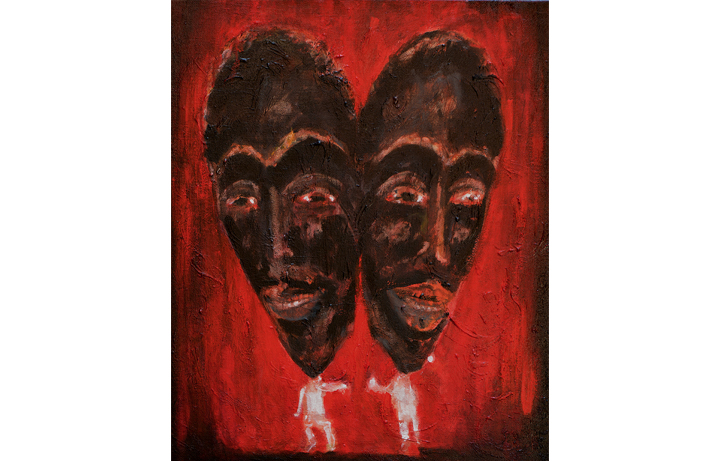
I nativi
Technique: Oil painting on canvasDimensions: 60x70cm2021Critical signsSergio BoldrinFirst Mask
Men and their masks, an inseparable whole, take on a leading role in the new pictorial cycle of the Venetian artist Sergio Boldrin.
The artist's proposal is an emotionally-charged pictorial reflection which, like a "slap," leads to the primordial being, thoroughly exploring its most intrinsic nature.
Such exploration, however, aims to stress men's figure rather than the mask, leaving to the latter the major task of revealing men's most obscure traits while uncovering their true identity.
Boldrin, while drawing on his enormous knowledge as a master "mascarer," a constant cause for reflection for him, managed as a painter to escape from the heap of masks that accompany his every day, succeeding in unearthing the mask's meaning for the deepest self which any human has faced since the dawn of time.
In this selection of pictorial works, in fact, the mask is not intended in the theatrical terms of the "Commedia dell'Arte" or those of Carnival, but in an intimate and spiritual way, and is seen mainly in its innate appearance as a primordial face: men, the very moment they open their eyes to the world, receive a mask they will wear to their grave.
Referring to this concept, Boldrin drew inspiration from African masks to create his works. Other artists had already taken them as a point of reference in the past, in particular various exponents of Cubism, Fauvism and Expressionism in the avant-garde period of the twentieth century.
Boldrin's vision is nonetheless entirely new and, in a strikingly original conceptual and artistic approach, invites us to look back at the early fusion of men and mask that – erected as symbols – infuse the traits of each mortal. In particular, to underline the duality of a psychological component, Boldrin refers to the anonymous work "Mask of Zaire" kept at the Royal Museum of Central Africa, from which Picasso already drew inspiration – although with a primarily geometric interest – to realise "Les Demoiselles D’Avignon."
In his works, Boldrin depicts each new-born being entrusted with a mask as a small, white figure in embryonic and evanescent form, the symbol of a pure and authentic soul at the beginning of a new life. This figure holds up the great mask ready to wear it, with ever-changing gestures, with graceful and fluttering characters, never completely defined.
Boldrin, indeed, represents diverse "natives," each poised to be unique as regards their physiognomic, psychological, personality, and behavioural features.
There are masks overtly possessed by a demonic stance, conveyed through the warm pigments of the scarlet and blood red, and whose fiery eyes express the yearnings of a tormented and tormenting soul. Others, with darker hues, full of melancholy and mystery, recall signs of suffering, struggle and war. There are some in which the idea of a more serene soul devoted to reflection and analysis prevails, while others have a dreamier inclination and connect with a dancing and philosophical world. And again, masks with earthly colours – which appear more goliardic – recall pastoral and bucolic scenes.
These works present a strong figurative component which is aptly combined with the most abstract part, reminiscent of dreams and imagination. At times, the space becomes nearly theatrical, while other times the background turns largely abstract and adorned with psychological connotations. If masks on certain works show a marked, largely geometric structure, others merge with the being behind them to the point of adopting more human traits, as if they were a second skin.
Finally, the last work, on an almost black purple background, recovers the first mask of the exhibition which now – repainted in white – offers a ghostly appearance.
This work represents the end of life, the last moment men will wear their mask and in which both will cancel out.
A reflection that is narrated in works characterised by gestural instinct and intelligent tone calibration, between contrasts designed to emphasise sensations and moods, in colours as intense as life itself.
Francesca Catalano - Art critic and curator
-
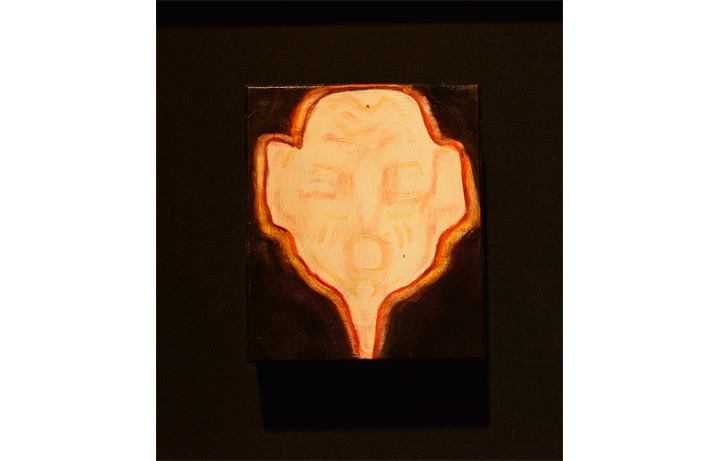
Ultima maschera
Technique: Oil on the table Dimensions: 15x18cm2021Critical signsSergio BoldrinFirst Mask
Men and their masks, an inseparable whole, take on a leading role in the new pictorial cycle of the Venetian artist Sergio Boldrin.
The artist's proposal is an emotionally-charged pictorial reflection which, like a "slap," leads to the primordial being, thoroughly exploring its most intrinsic nature.
Such exploration, however, aims to stress men's figure rather than the mask, leaving to the latter the major task of revealing men's most obscure traits while uncovering their true identity.
Boldrin, while drawing on his enormous knowledge as a master "mascarer," a constant cause for reflection for him, managed as a painter to escape from the heap of masks that accompany his every day, succeeding in unearthing the mask's meaning for the deepest self which any human has faced since the dawn of time.
In this selection of pictorial works, in fact, the mask is not intended in the theatrical terms of the "Commedia dell'Arte" or those of Carnival, but in an intimate and spiritual way, and is seen mainly in its innate appearance as a primordial face: men, the very moment they open their eyes to the world, receive a mask they will wear to their grave.
Referring to this concept, Boldrin drew inspiration from African masks to create his works. Other artists had already taken them as a point of reference in the past, in particular various exponents of Cubism, Fauvism and Expressionism in the avant-garde period of the twentieth century.
Boldrin's vision is nonetheless entirely new and, in a strikingly original conceptual and artistic approach, invites us to look back at the early fusion of men and mask that – erected as symbols – infuse the traits of each mortal. In particular, to underline the duality of a psychological component, Boldrin refers to the anonymous work "Mask of Zaire" kept at the Royal Museum of Central Africa, from which Picasso already drew inspiration – although with a primarily geometric interest – to realise "Les Demoiselles D’Avignon."
In his works, Boldrin depicts each new-born being entrusted with a mask as a small, white figure in embryonic and evanescent form, the symbol of a pure and authentic soul at the beginning of a new life. This figure holds up the great mask ready to wear it, with ever-changing gestures, with graceful and fluttering characters, never completely defined.
Boldrin, indeed, represents diverse "natives," each poised to be unique as regards their physiognomic, psychological, personality, and behavioural features.
There are masks overtly possessed by a demonic stance, conveyed through the warm pigments of the scarlet and blood red, and whose fiery eyes express the yearnings of a tormented and tormenting soul. Others, with darker hues, full of melancholy and mystery, recall signs of suffering, struggle and war. There are some in which the idea of a more serene soul devoted to reflection and analysis prevails, while others have a dreamier inclination and connect with a dancing and philosophical world. And again, masks with earthly colours – which appear more goliardic – recall pastoral and bucolic scenes.
These works present a strong figurative component which is aptly combined with the most abstract part, reminiscent of dreams and imagination. At times, the space becomes nearly theatrical, while other times the background turns largely abstract and adorned with psychological connotations. If masks on certain works show a marked, largely geometric structure, others merge with the being behind them to the point of adopting more human traits, as if they were a second skin.
Finally, the last work, on an almost black purple background, recovers the first mask of the exhibition which now – repainted in white – offers a ghostly appearance.
This work represents the end of life, the last moment men will wear their mask and in which both will cancel out.
A reflection that is narrated in works characterised by gestural instinct and intelligent tone calibration, between contrasts designed to emphasise sensations and moods, in colours as intense as life itself.
Francesca Catalano - Art critic and curator
-
